
Steal like an Rtist: Creative Coding in R
Infinite Truchet
Roni Kaufman
posit::conf(2023)
Infinite Truchet by Roni Kaufman
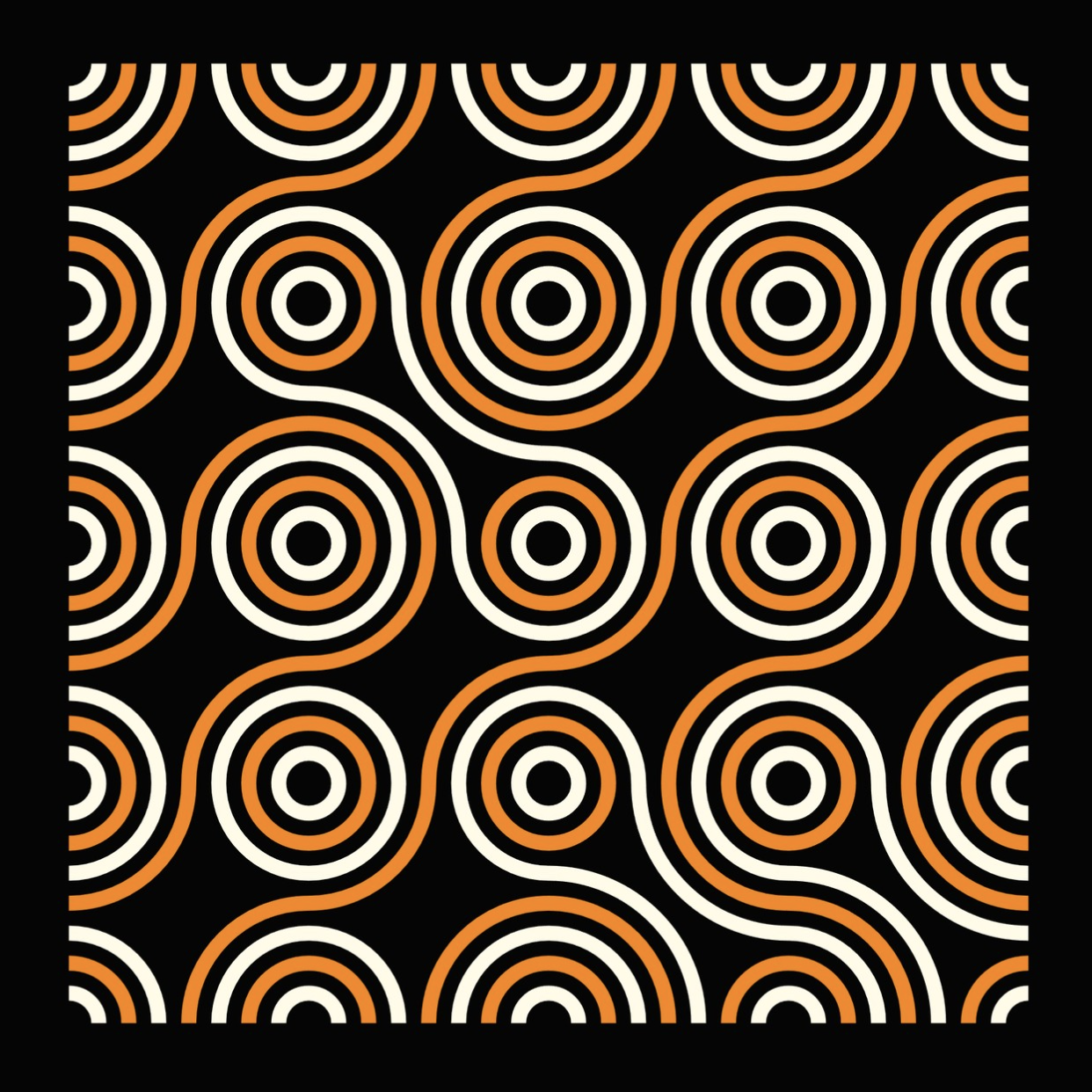
- Roni Kaufman is a self-described, creative coder and generative artist
- He regularly shares the code to his projects on openprocessing.org. This sketch is available at Open Processing
- Released under a CC BY-NC-SA 3.0 license (share and remix with attribution for noncommercial purposes)
Infinite Truchet: Color palette

Infinite Truchet: Composition
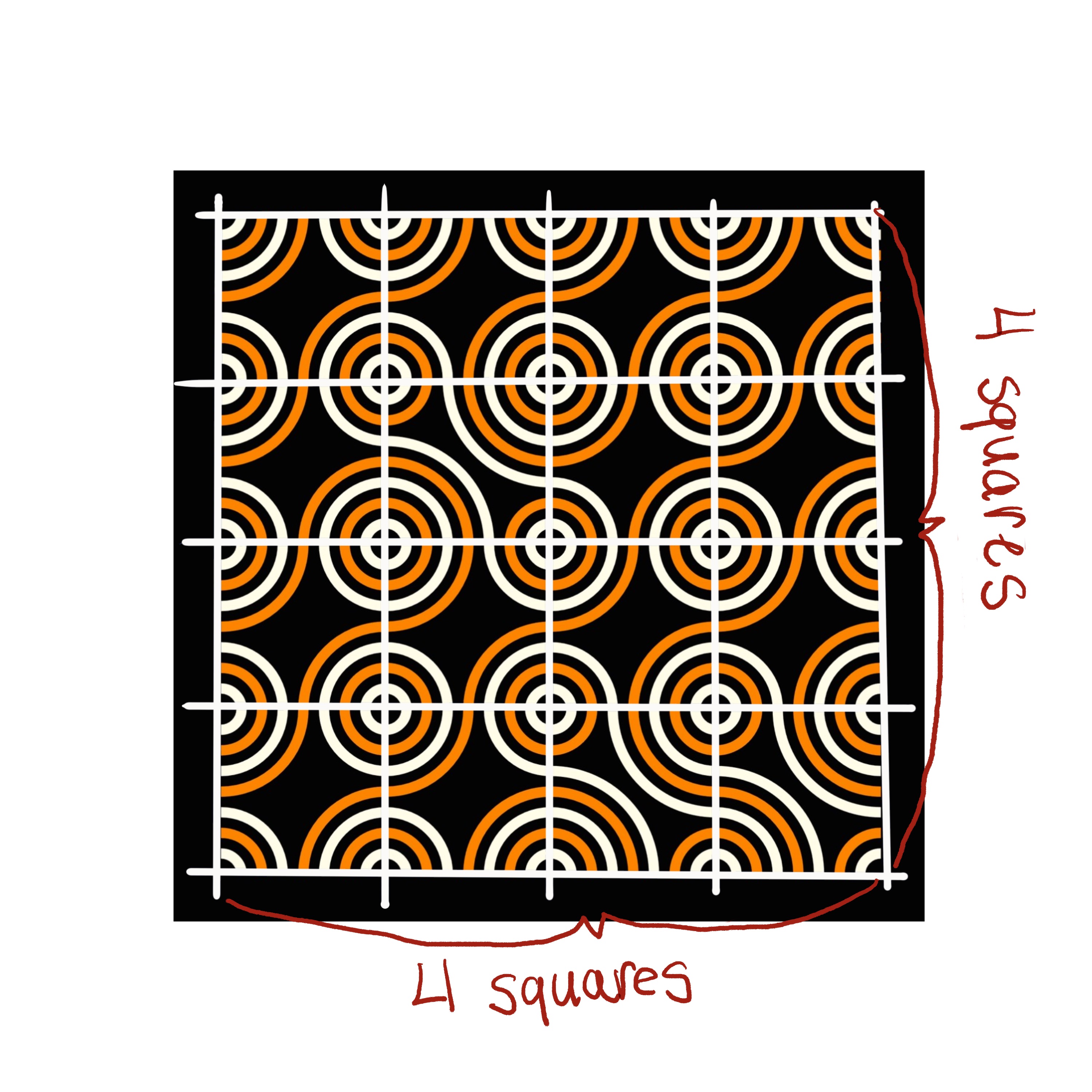
Infinite Truchet: Tiles
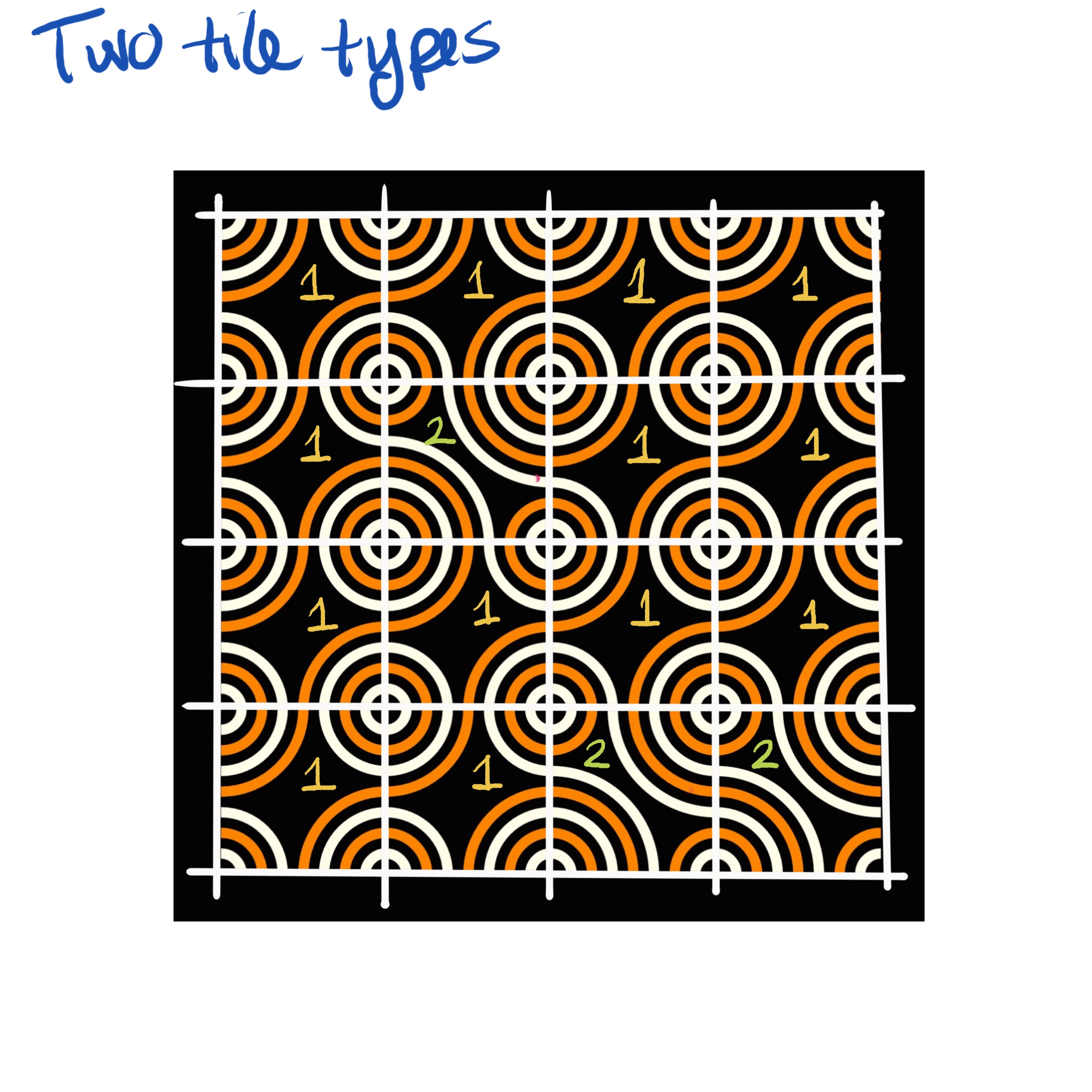
Introduction to tiles
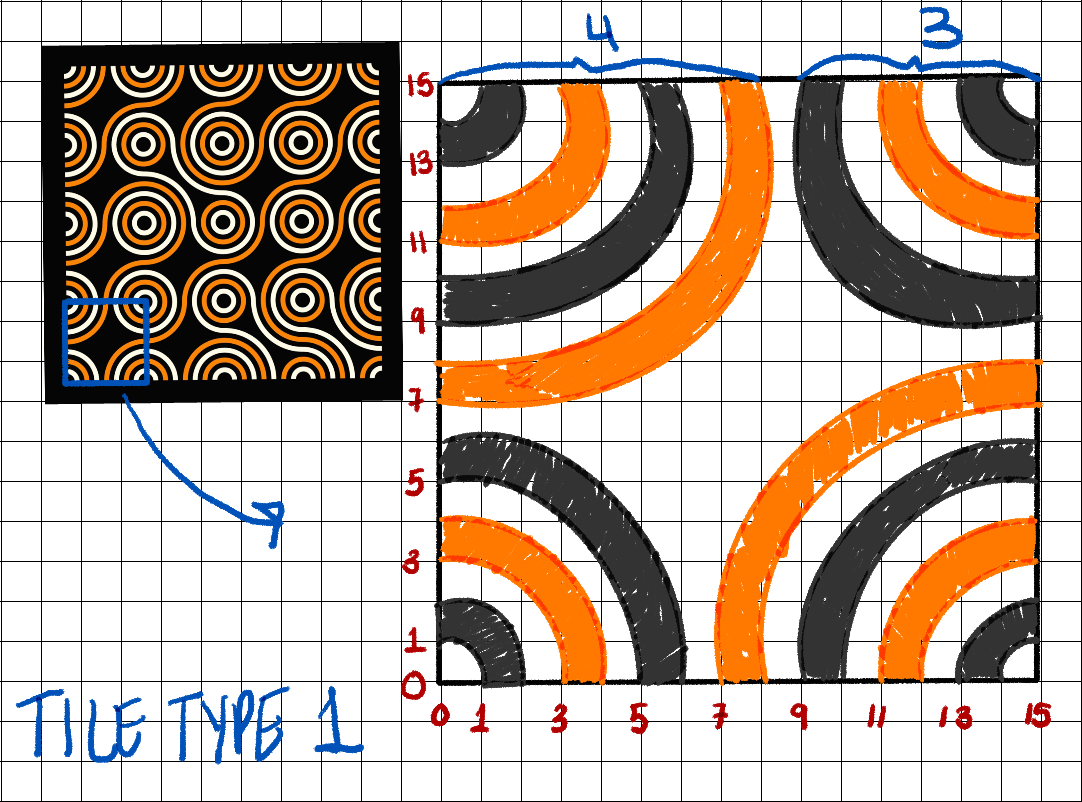
Introduction to tiles
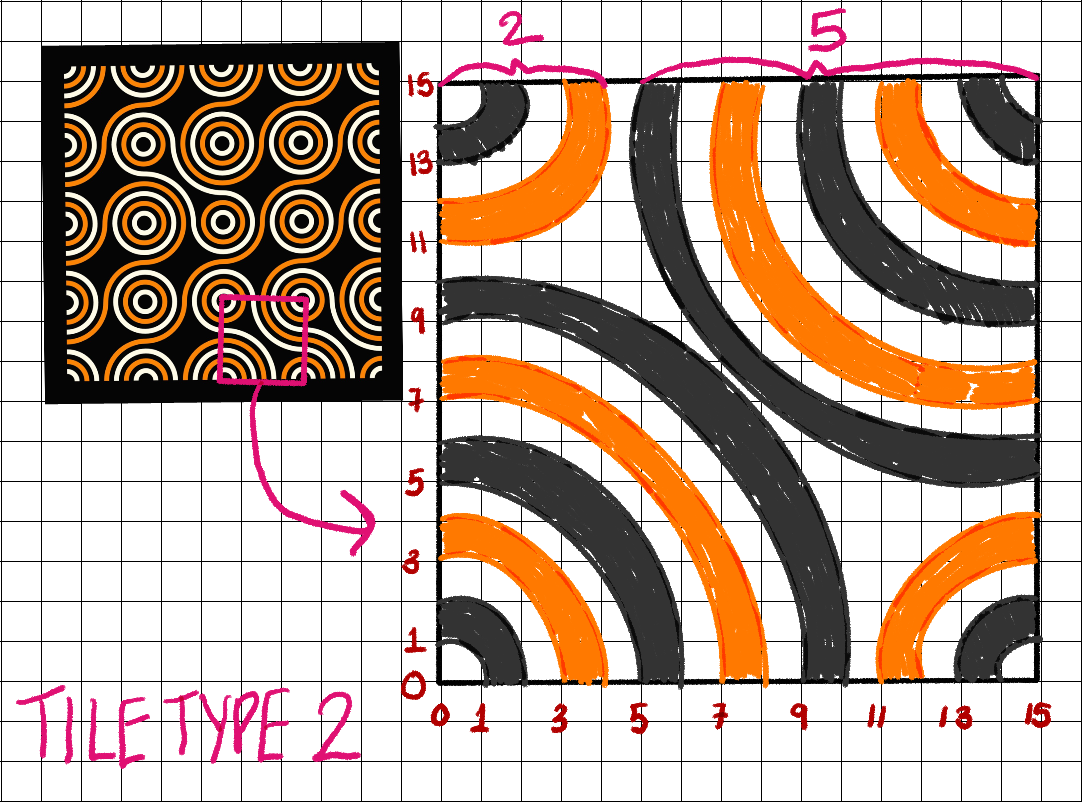
Introduction to tiles

Introduction to tiles
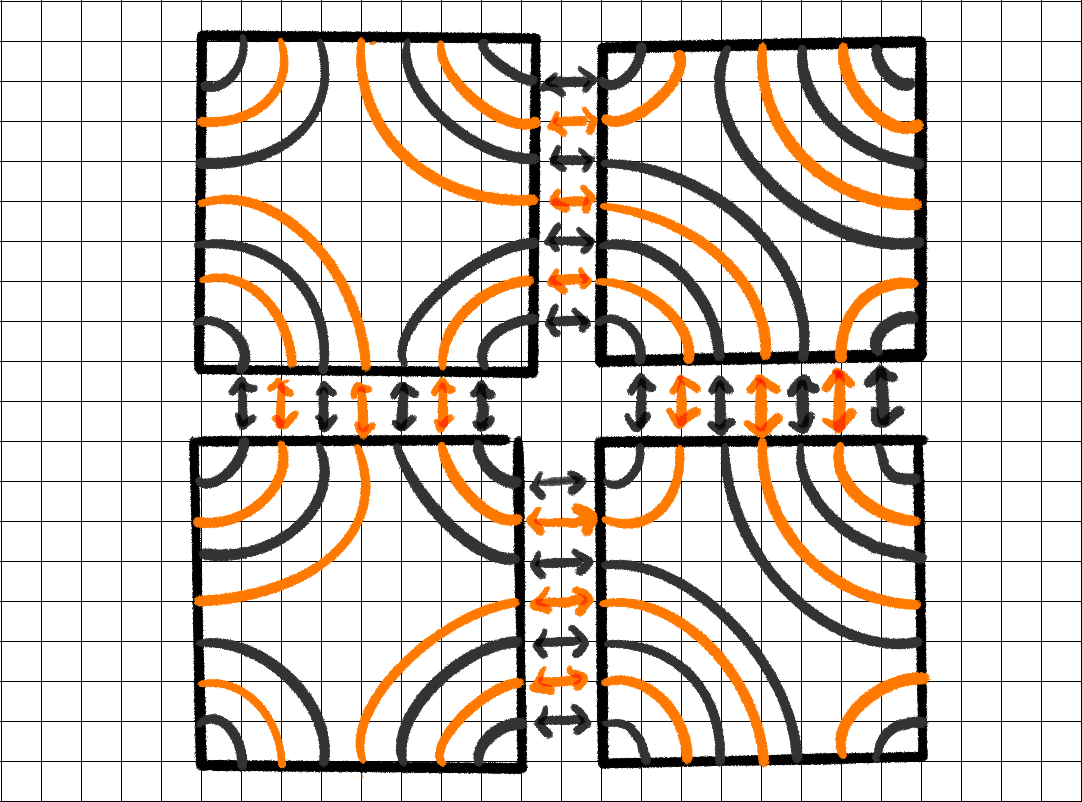
Truchet Tiles
The Father of Truchet Tiles
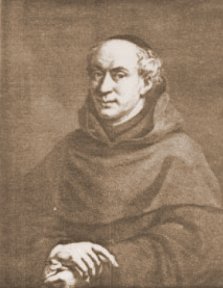
- French Dominican priest, 1657–1729
- Studied typography and invented the first typographic point
- Published “Memoir sur les combinaisons” that invented the idea of truchet tiles
Infinitely Variable Tiling Patterns: From Truchet to Sol LeWitt Revisited
“Memoir sur les combinaisons”
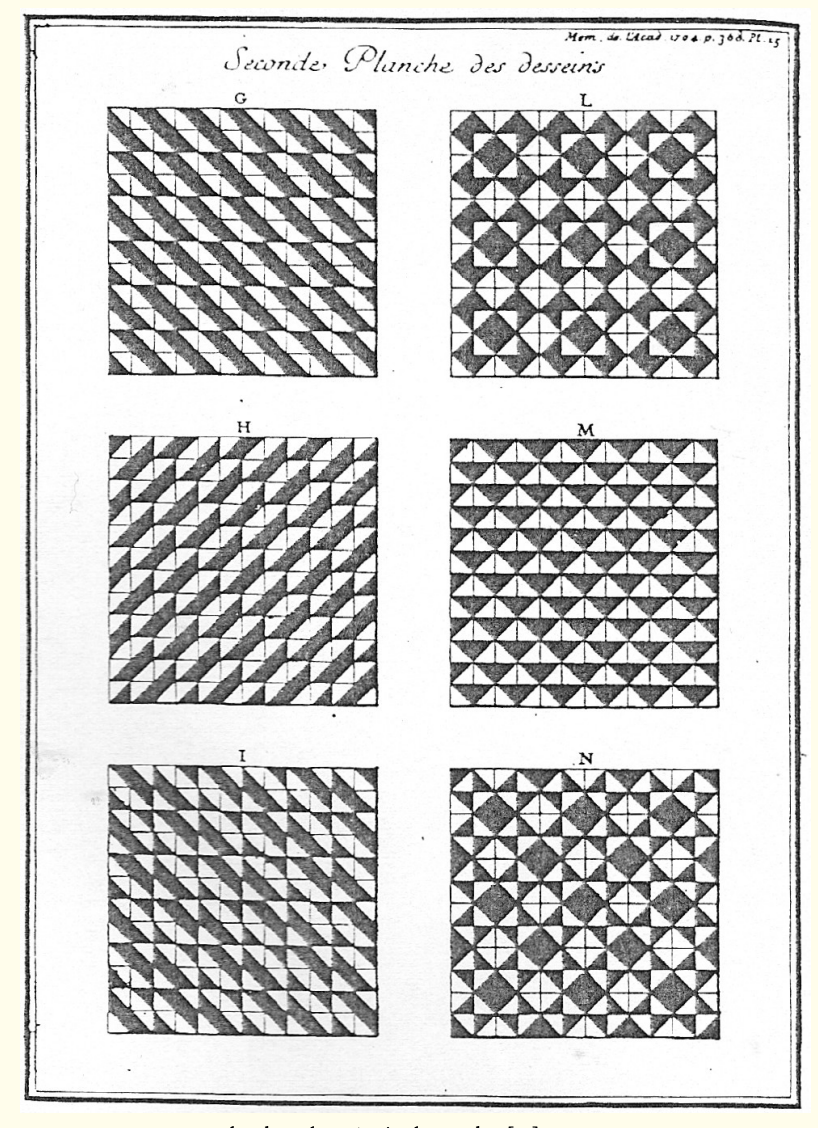
- Studied a pattern where square tiles are split by diagonal lines into two triangles with contrasting colors.
- By placing these tiles adjacent to each other but in different orientations, many different patterns can be formed.
Truchet Tiles
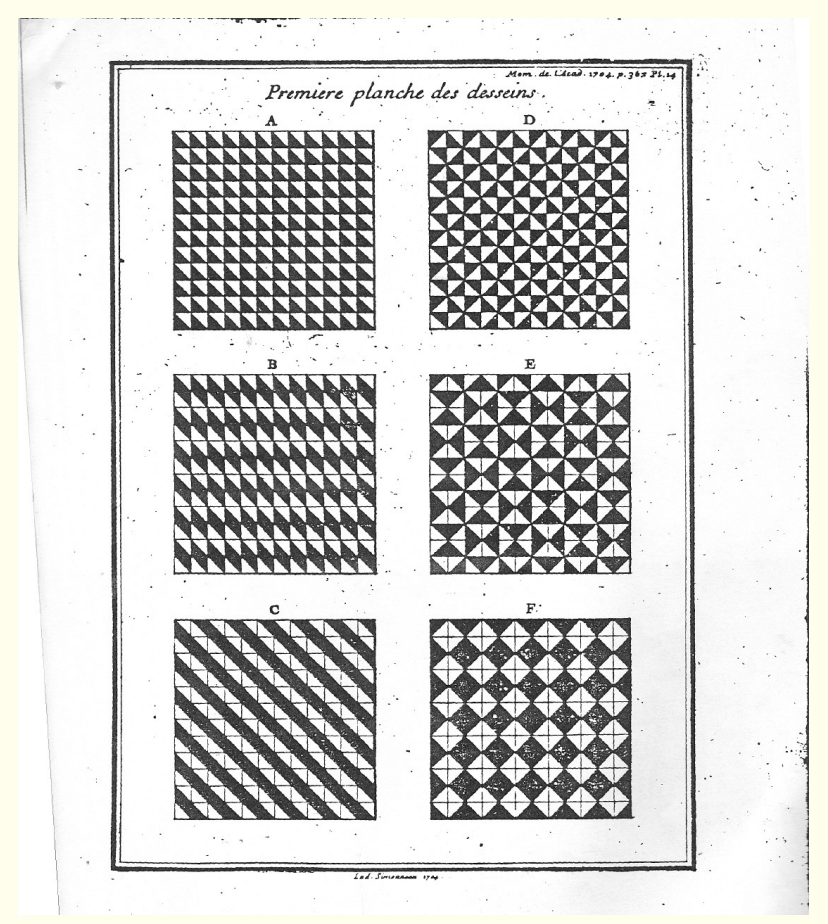
Initially, the underlying idea of truchet tiles is that adjacent tiles of right triangles make larger connecting patterns.
Infinitely Variable Tiling Patterns: From Truchet to Sol LeWitt Revisited
Truchet Tiles
Cyril Smith, 1987, analyzed truchet tiles and abstracted them into 1) diagonal lines, then 2) two arcs starting and ending at midpoints of the tiles edges.
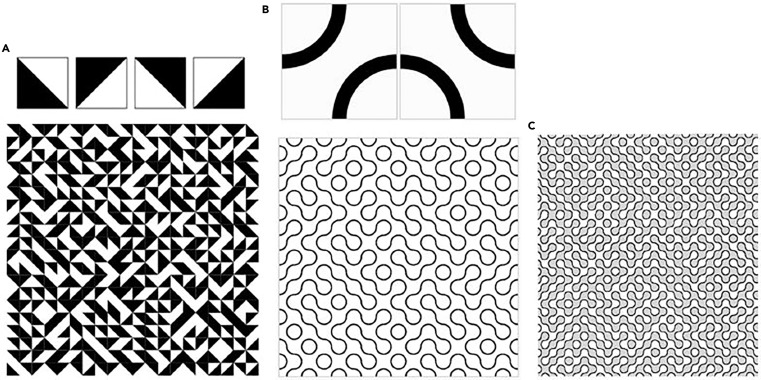
Robert J. Krawczyk, 2020
Infinitely Variable Tiling Patterns: From Truchet to Sol LeWitt Revisited
Multi-Scale Truchet Patterns
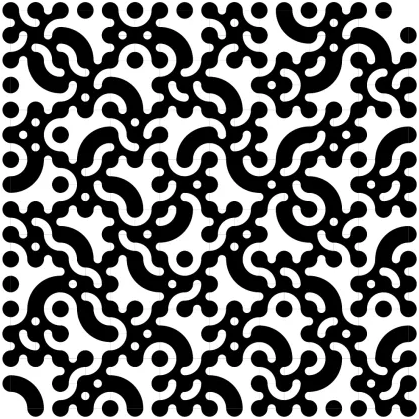
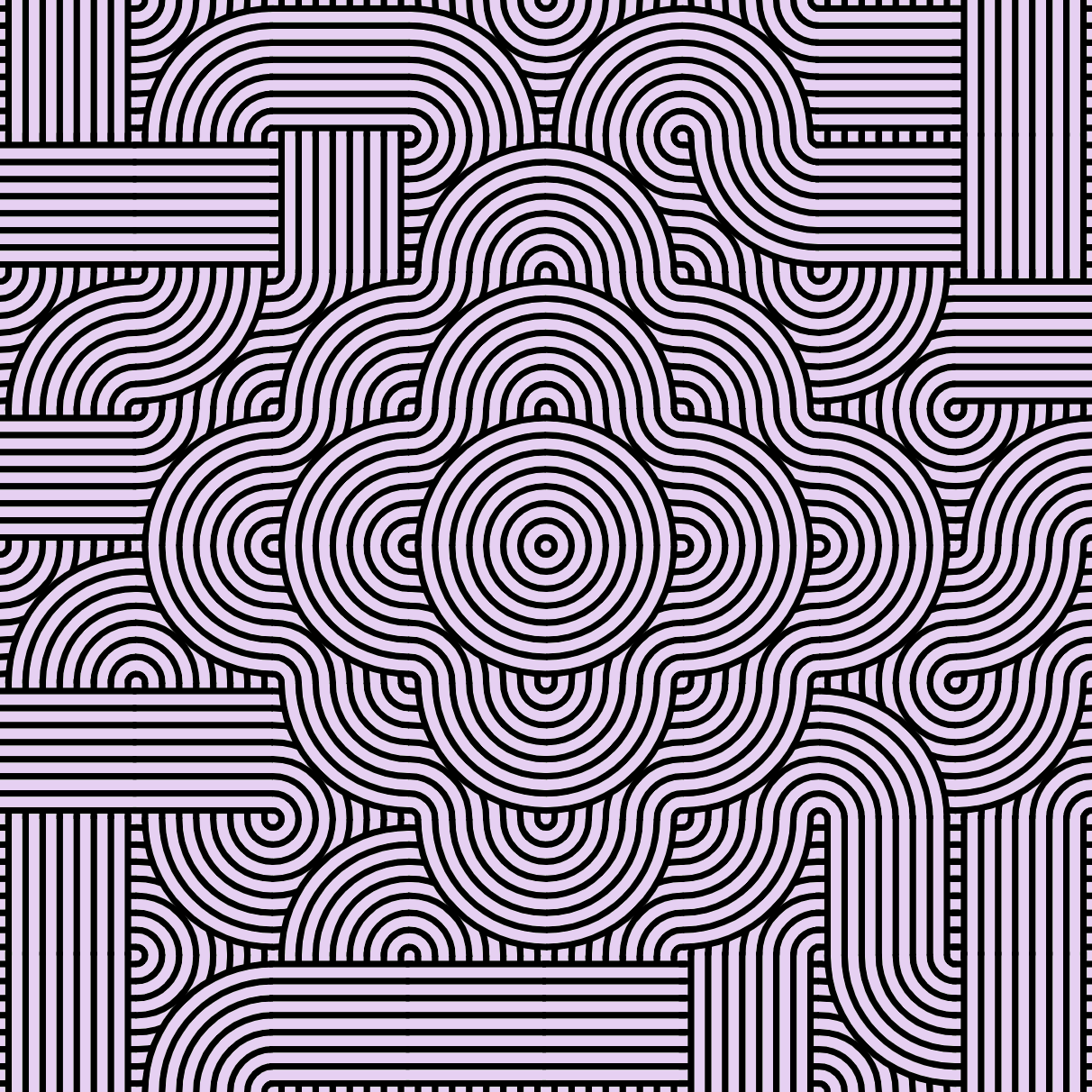
Exercise 1
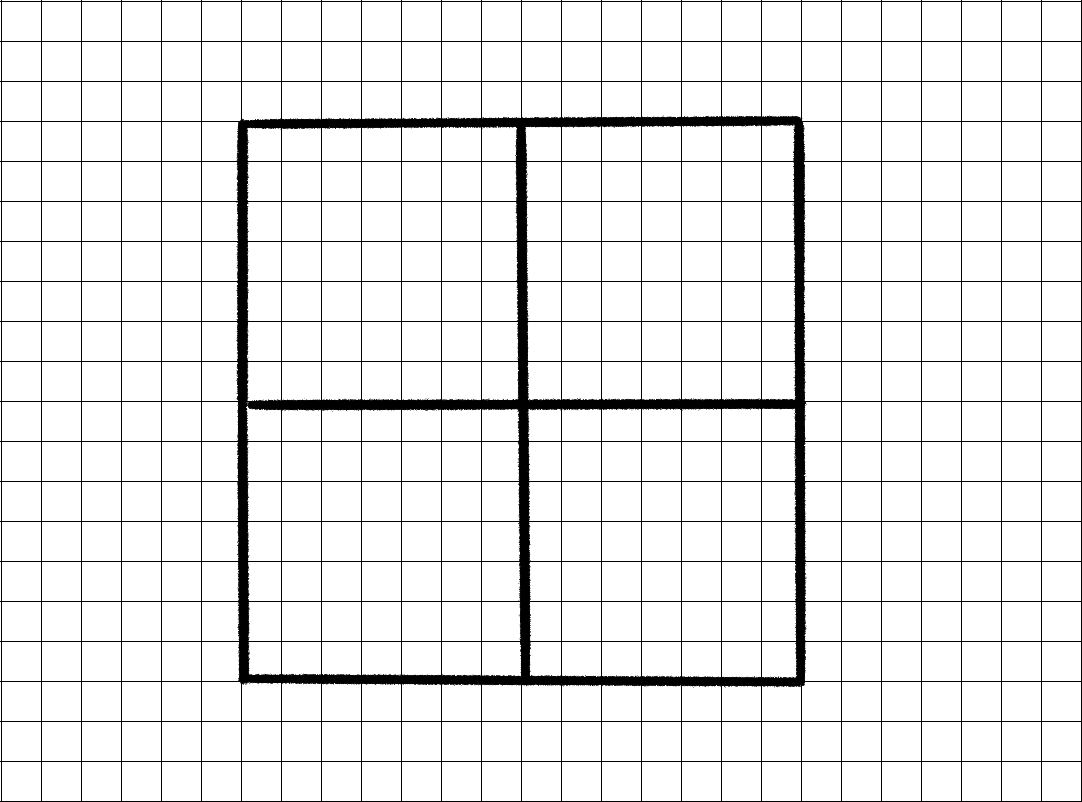
- Open the
exercises/05-infinite-truchet/truchet_tiles_examplesdirectory. These are different examples of truchet tiles. Choose one example. - Draw four squares on your graphing paper in a 2x2 format (see above).
- Draw four different rotations of your selected truchet tile example.
- Take a picture of your piece when finished and share it on the Github Discussions page.
10:00
Who actually needs trigonometric functions?
Creating arcs in {ggforce}
geom_arc_bar()
We will use the following aesthetics
x0,y0: x, y coordinate, center of arcstart: radian value of where arc startsend: radian value of where arc endsr0: radius of inner arcr: radius of outer arccolor,fill: color of arc
r vs r0
In this example, we have
r0as the inner radius andras the outer radius. {ggforce} allows you to also have it be vice versa.Most important thing is to remain consistent in your definitions across your code.
The simplifying of trigonometry
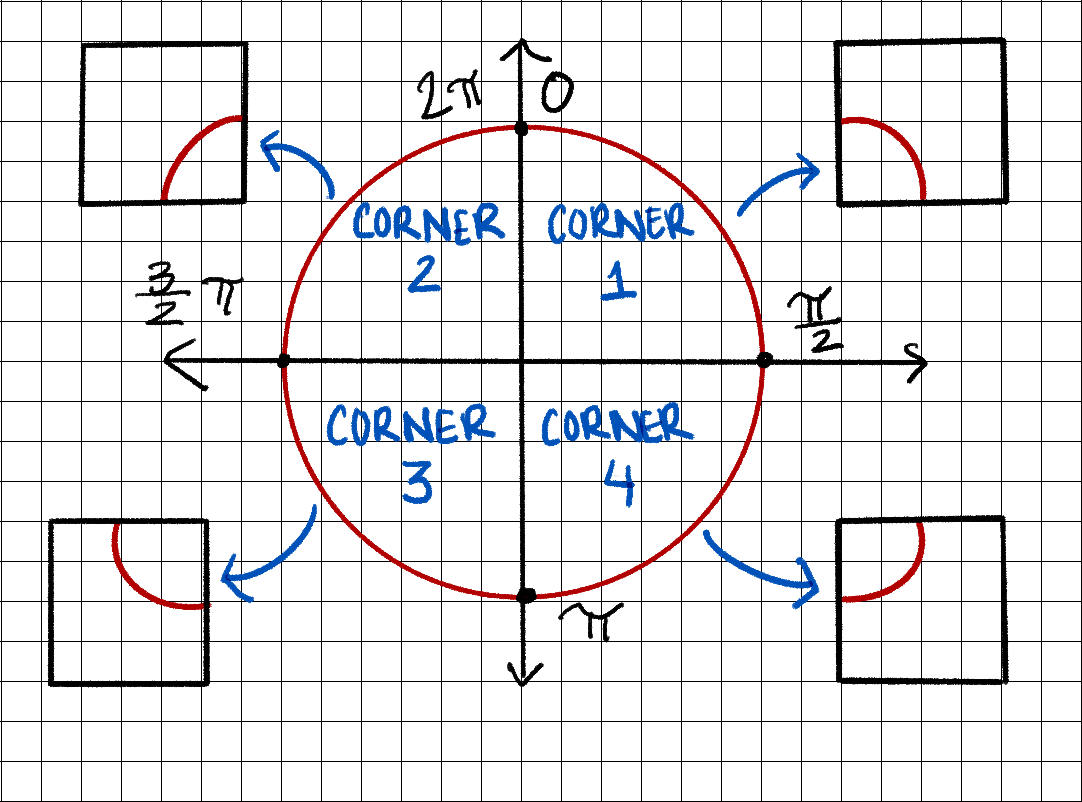
Creating arcs in {ggforce}
geom_arc_bar()
We will use the following aesthetics
x0,y0: x, y coordinate, center of arcstart: radian value of where arc startsend: radian value of where arc endsr0: radius of inner arcr: radius of outer arccolor,fill: color of arc
geom_arc_bar() arguments: x0, y0, start, end
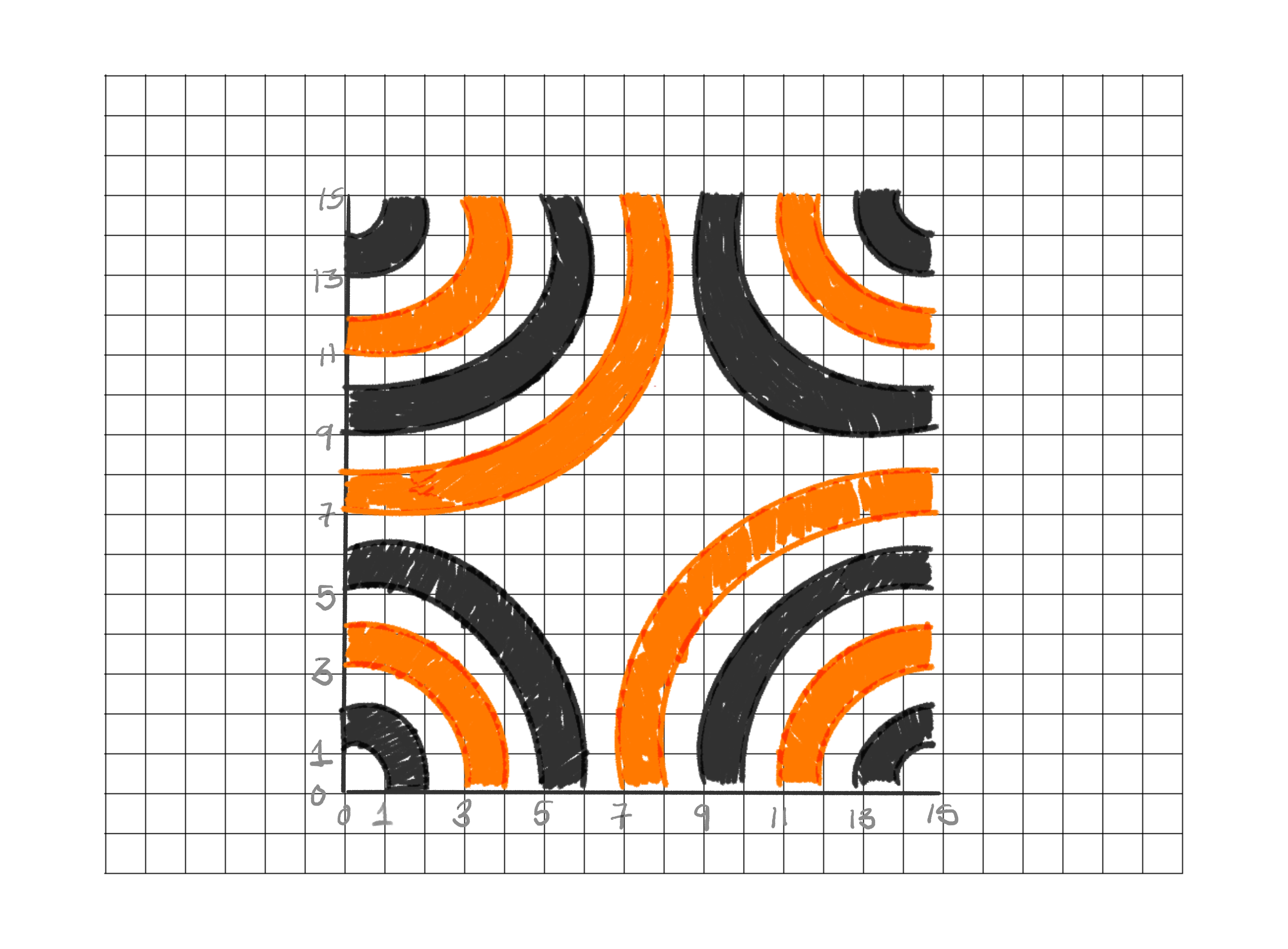
geom_arc_bar() arguments: x0, y0, start, end
Always travel counterclockwise, starting in bottom left
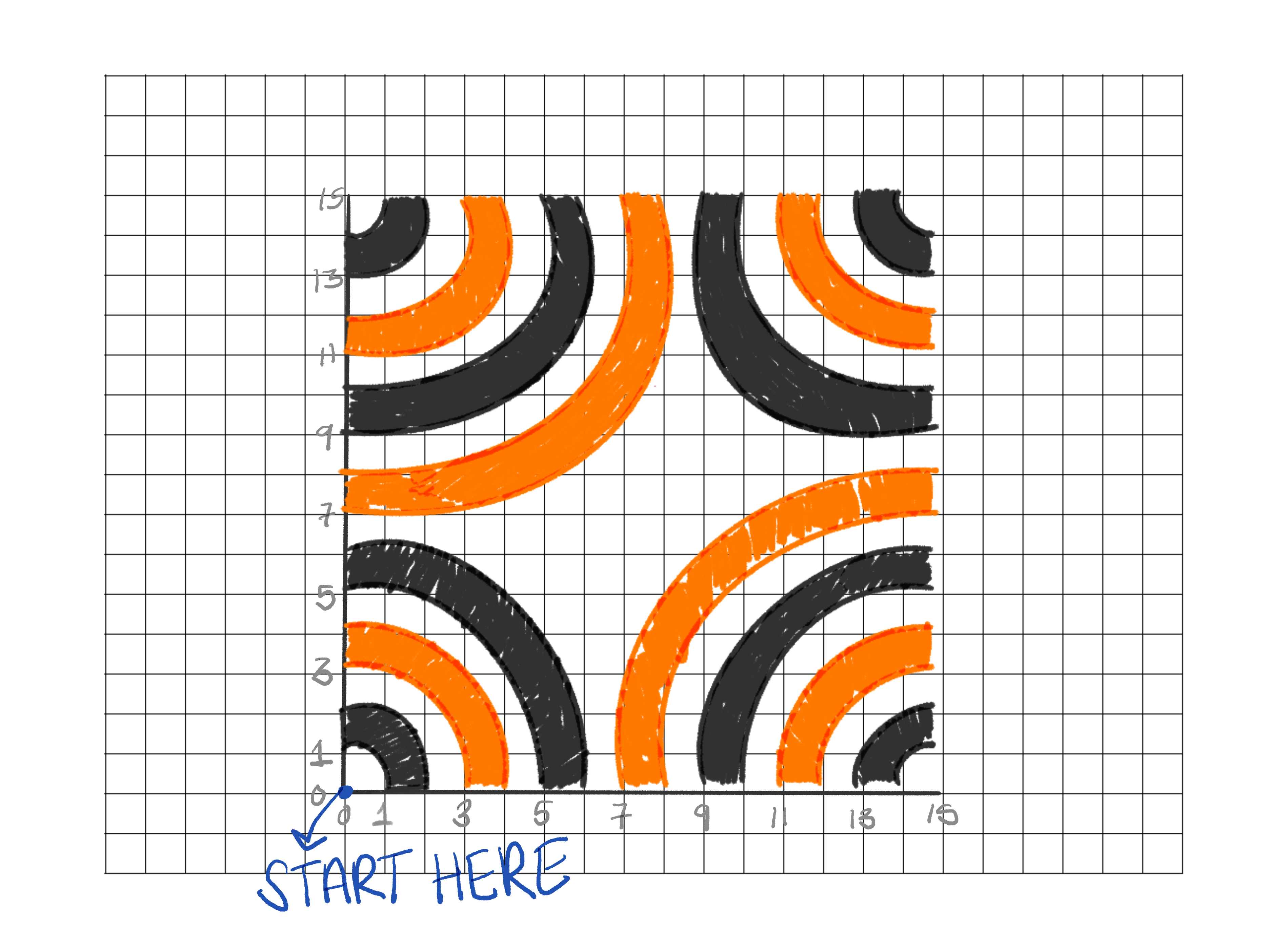
Corner 1
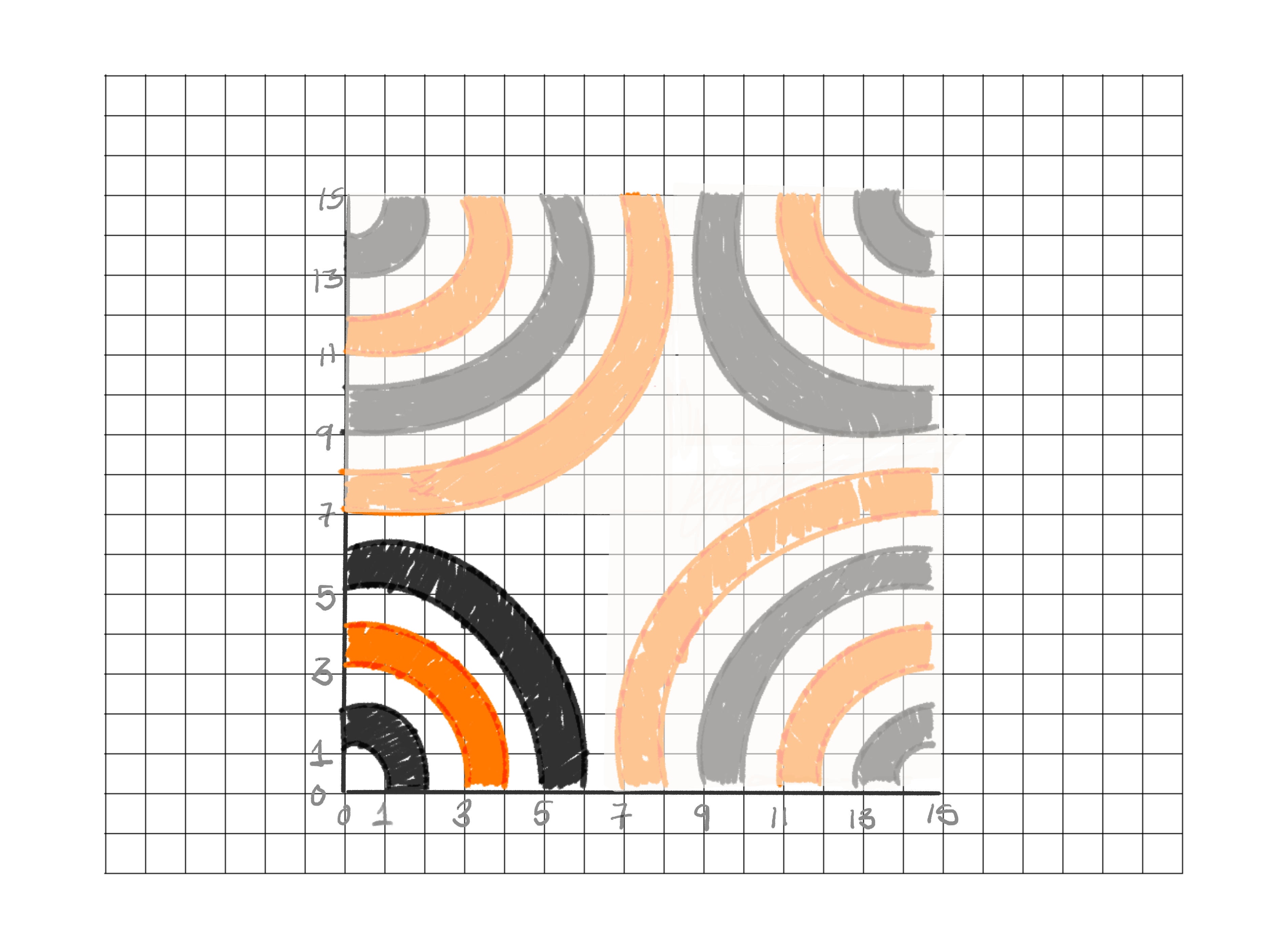
Corner 1: x0, y0
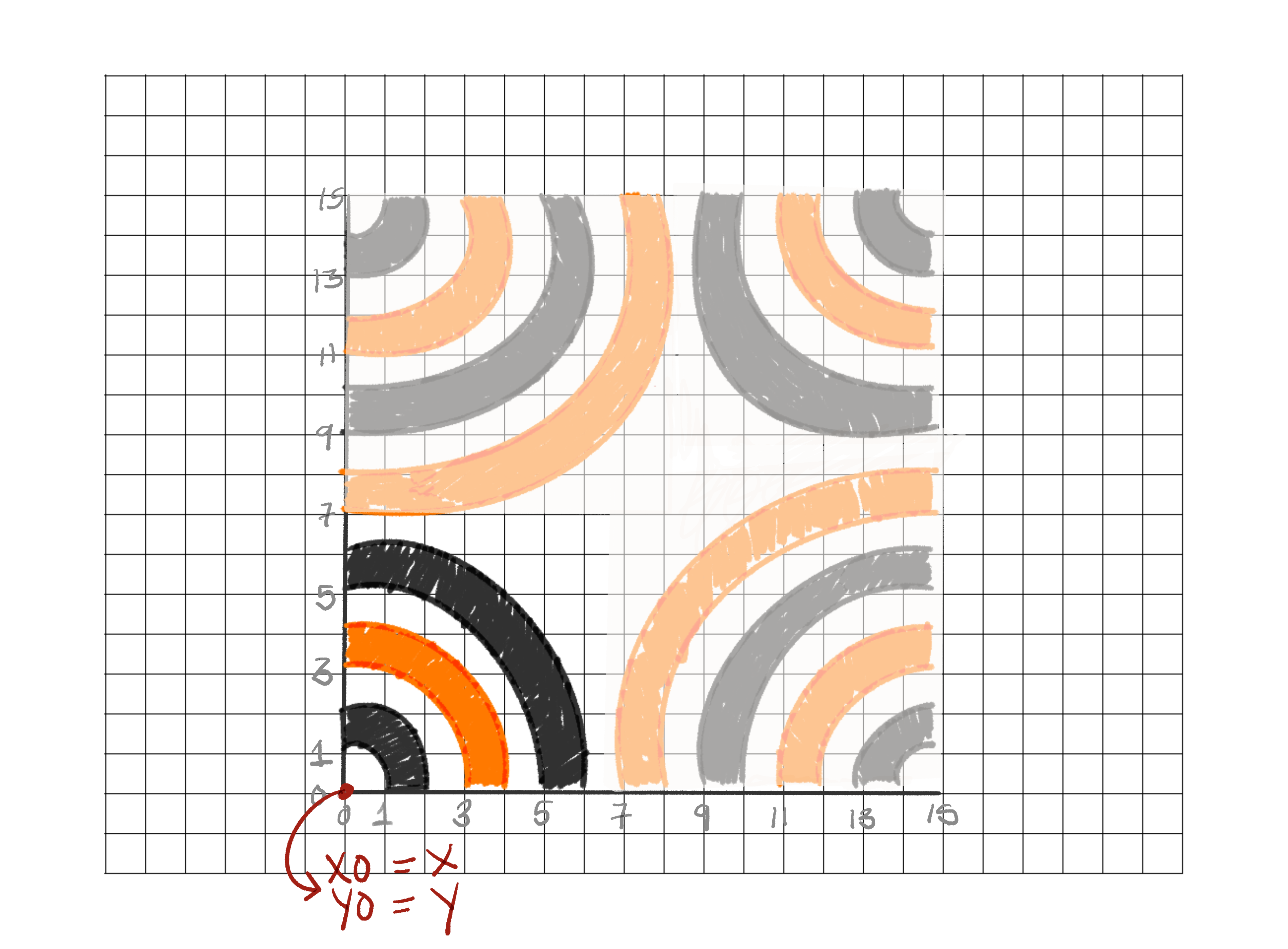
Corner 1: start, end
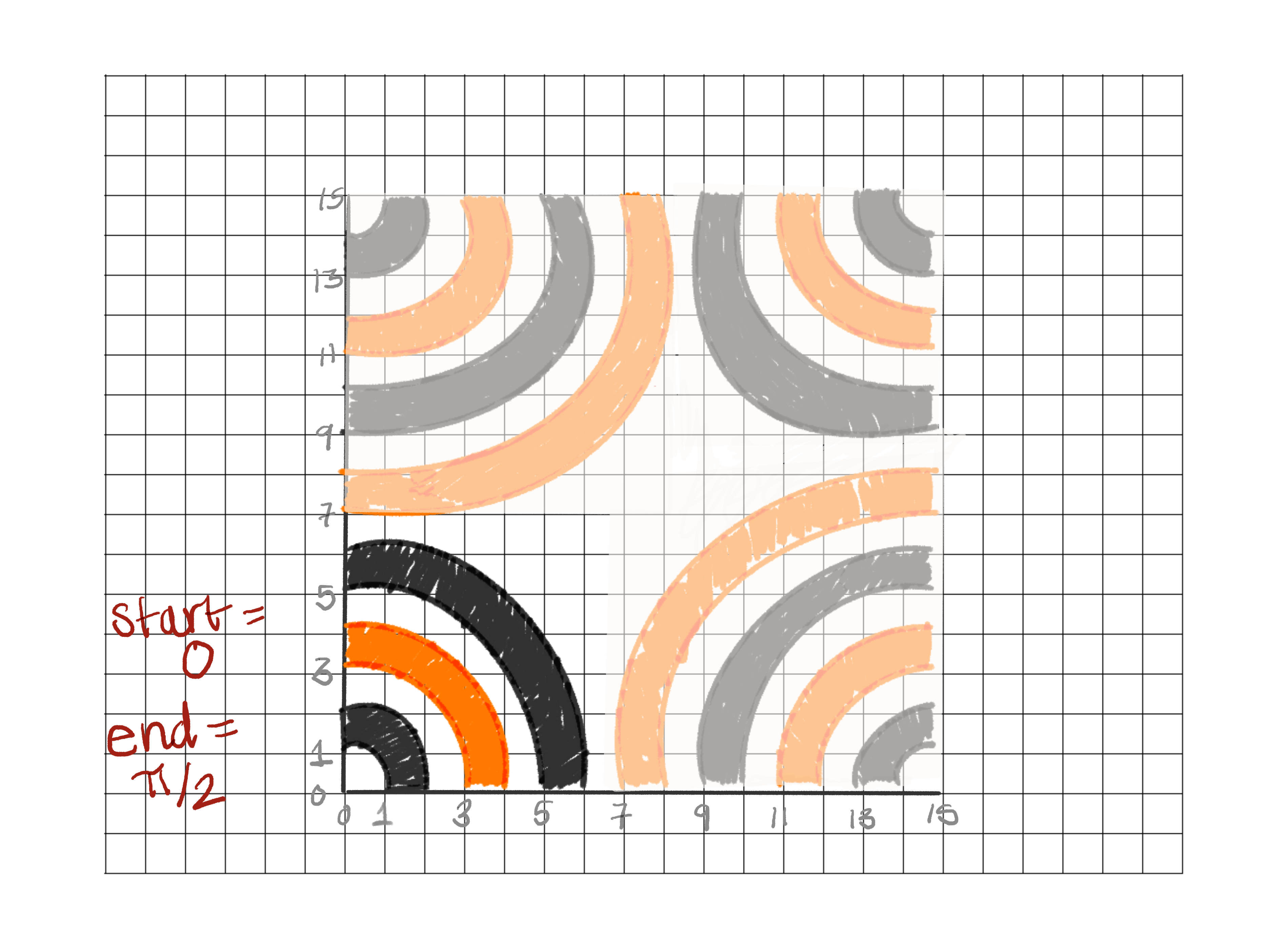
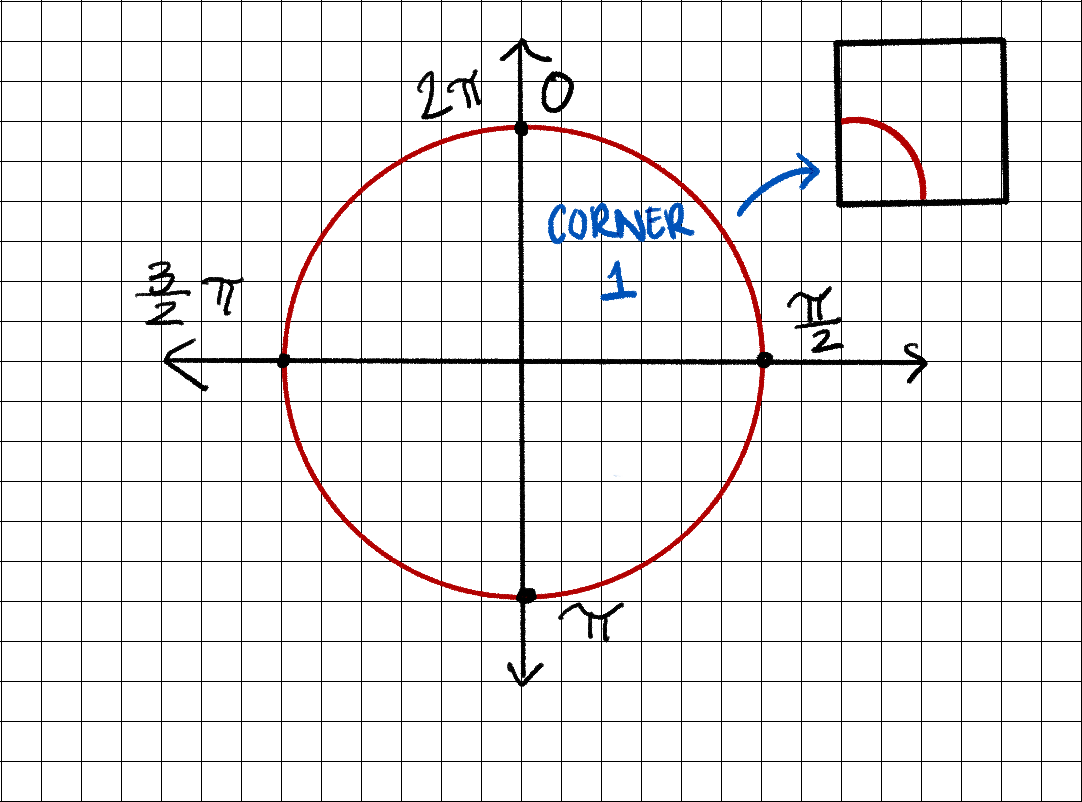
Corner 2
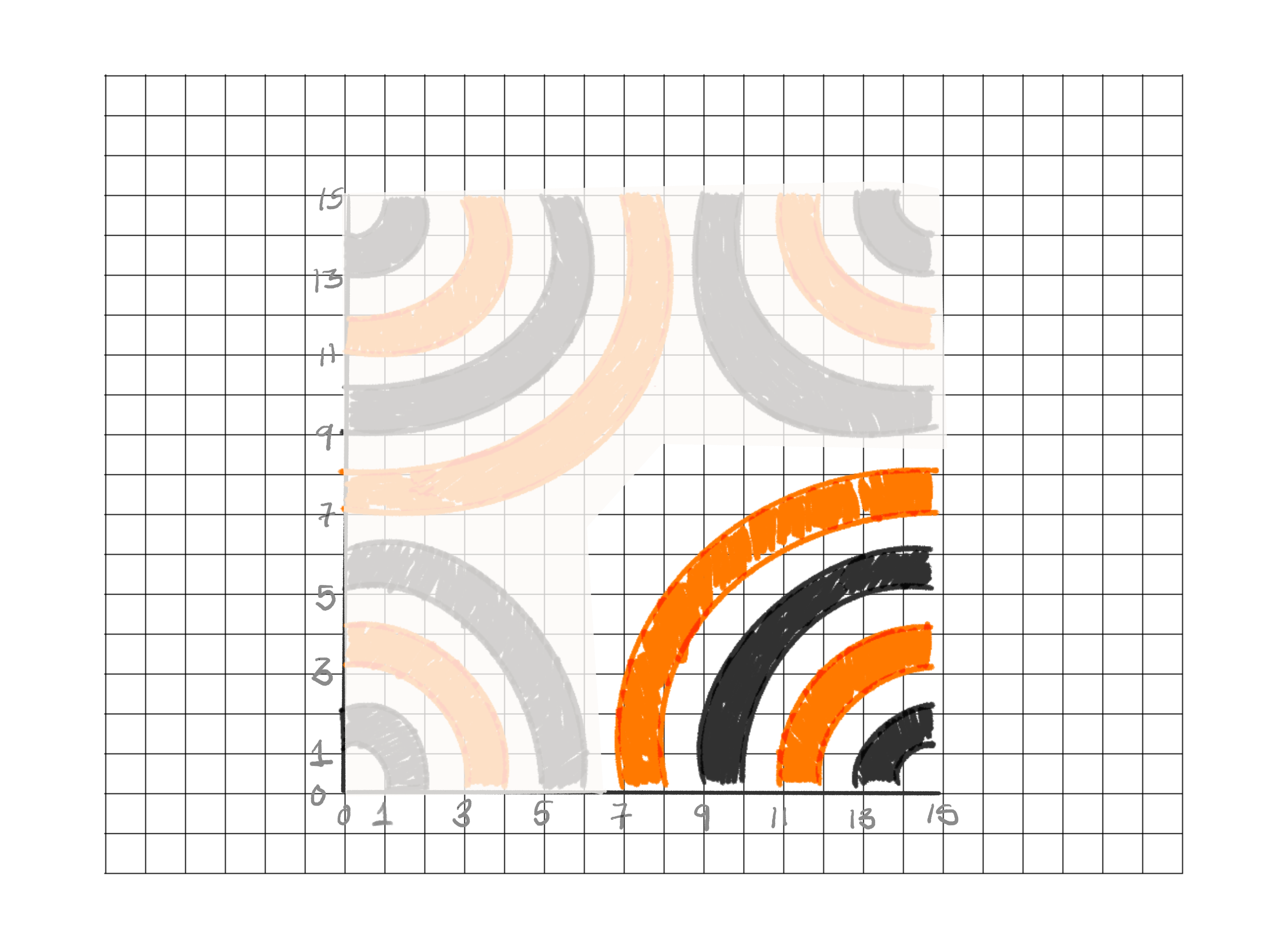
Corner 2: x0, y0
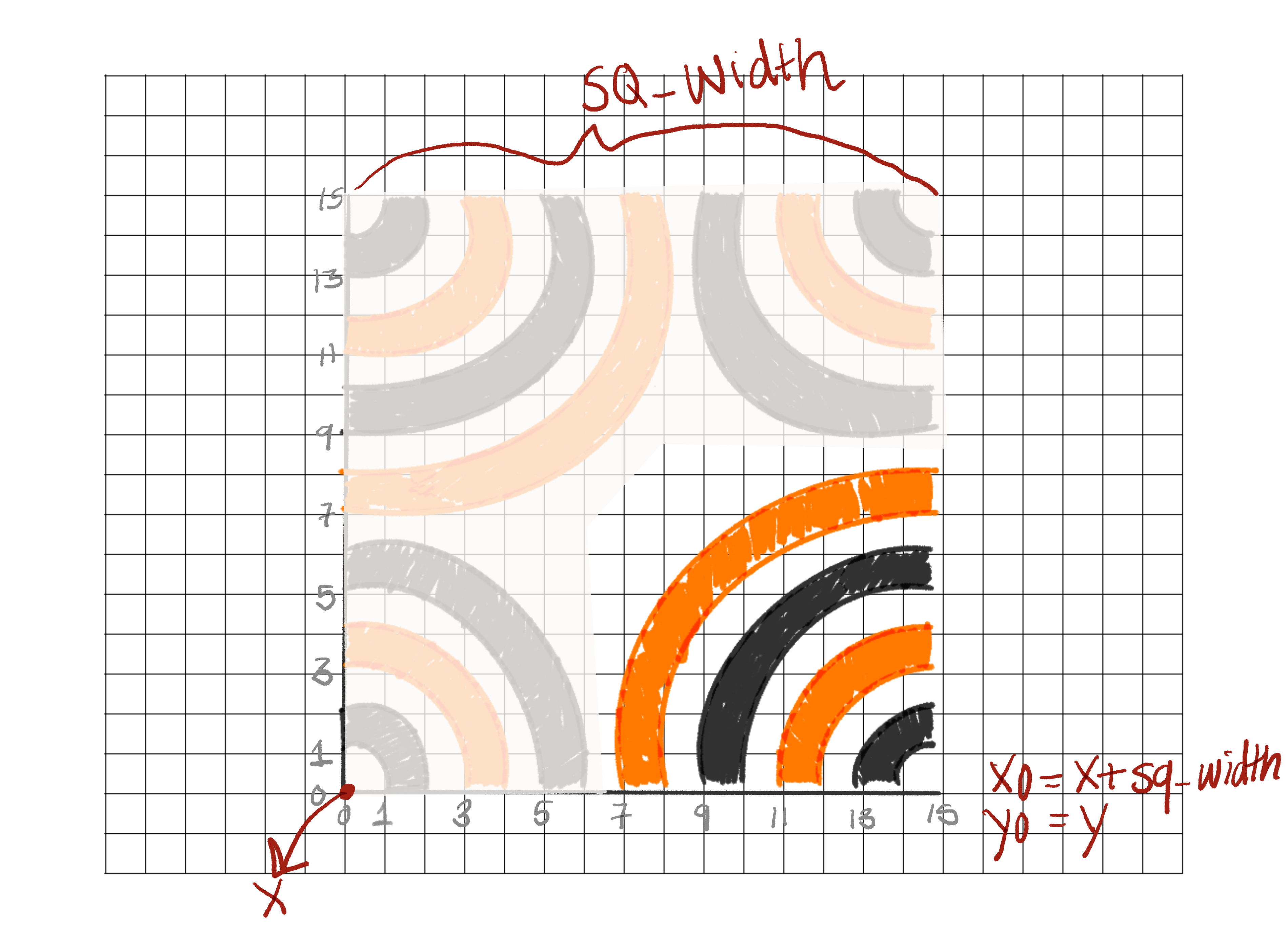
Corner 2: start, end
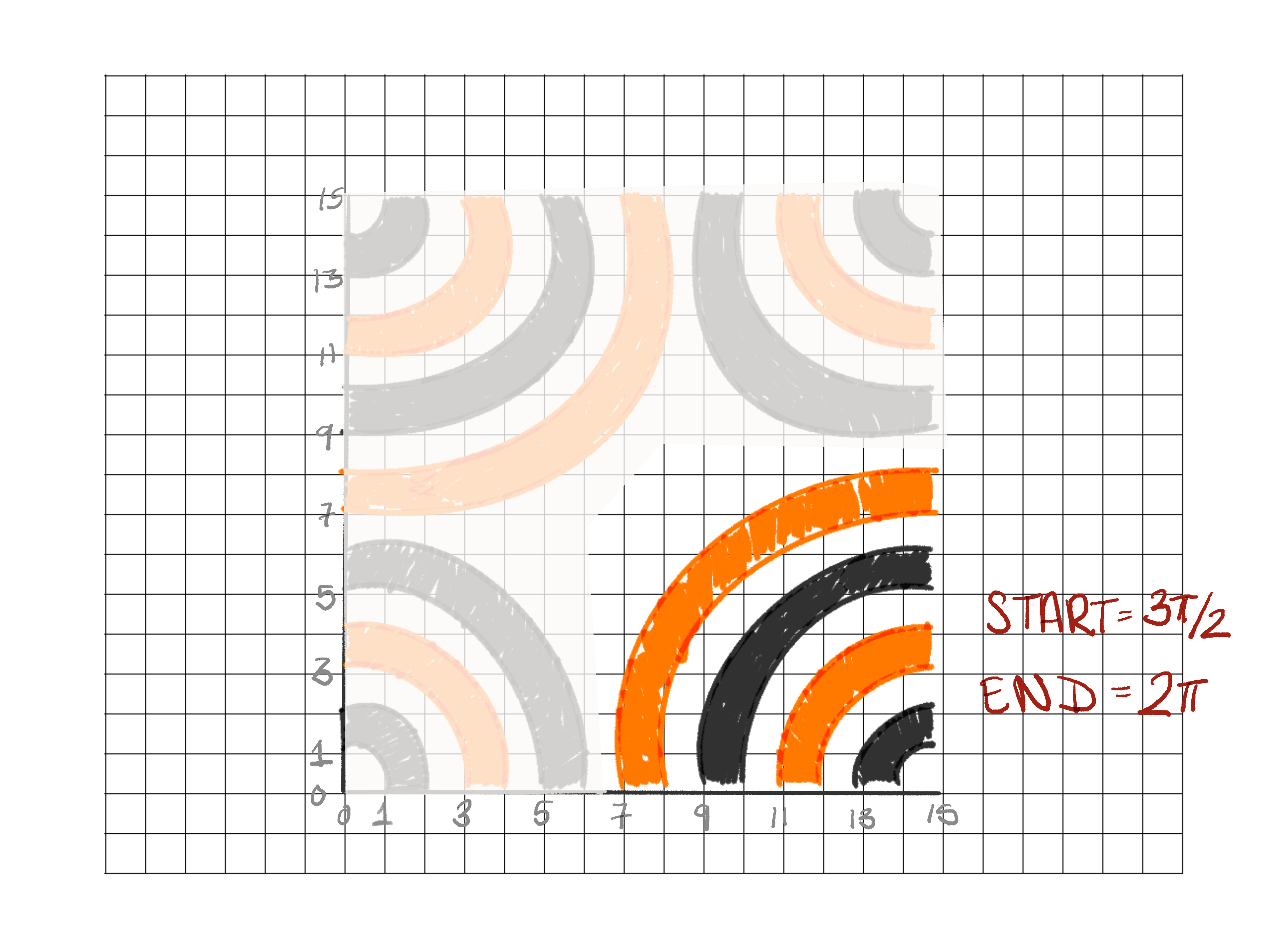
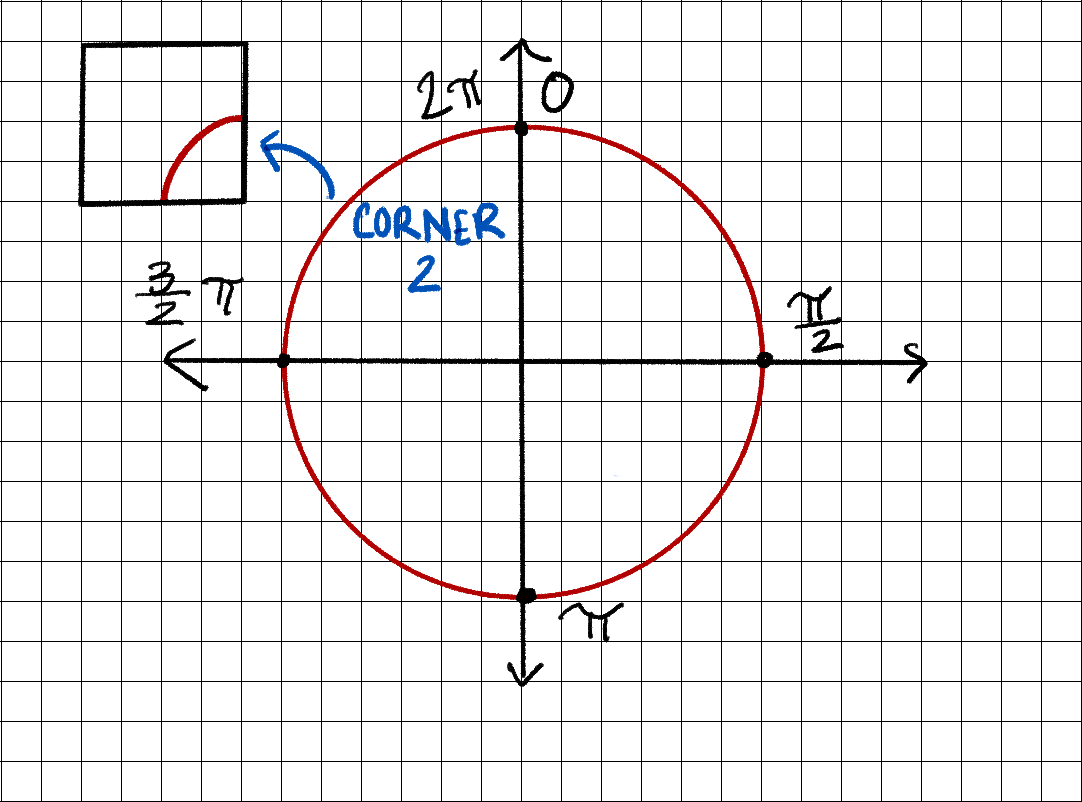
Corner 3
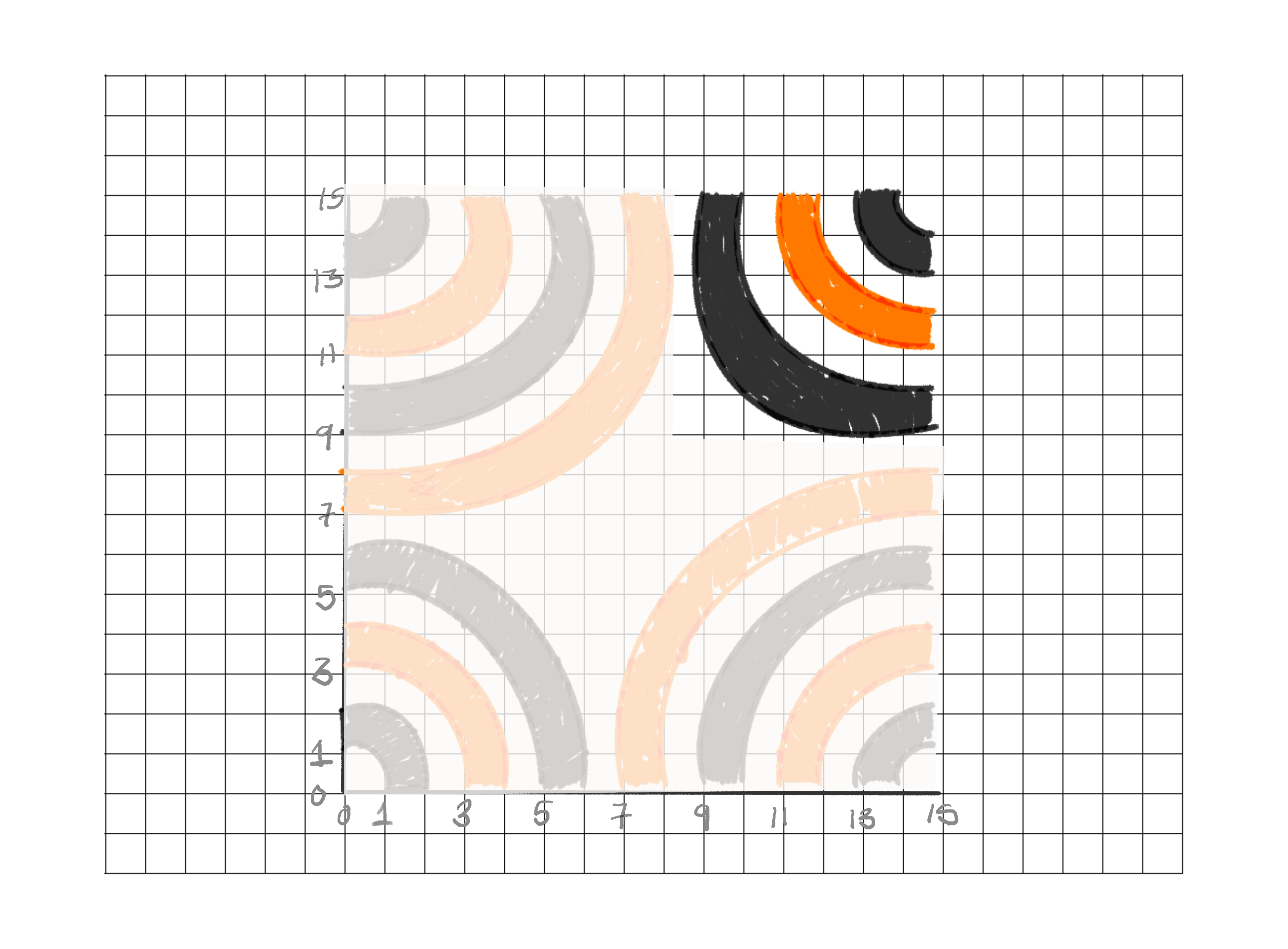
Corner 3: x0, y0
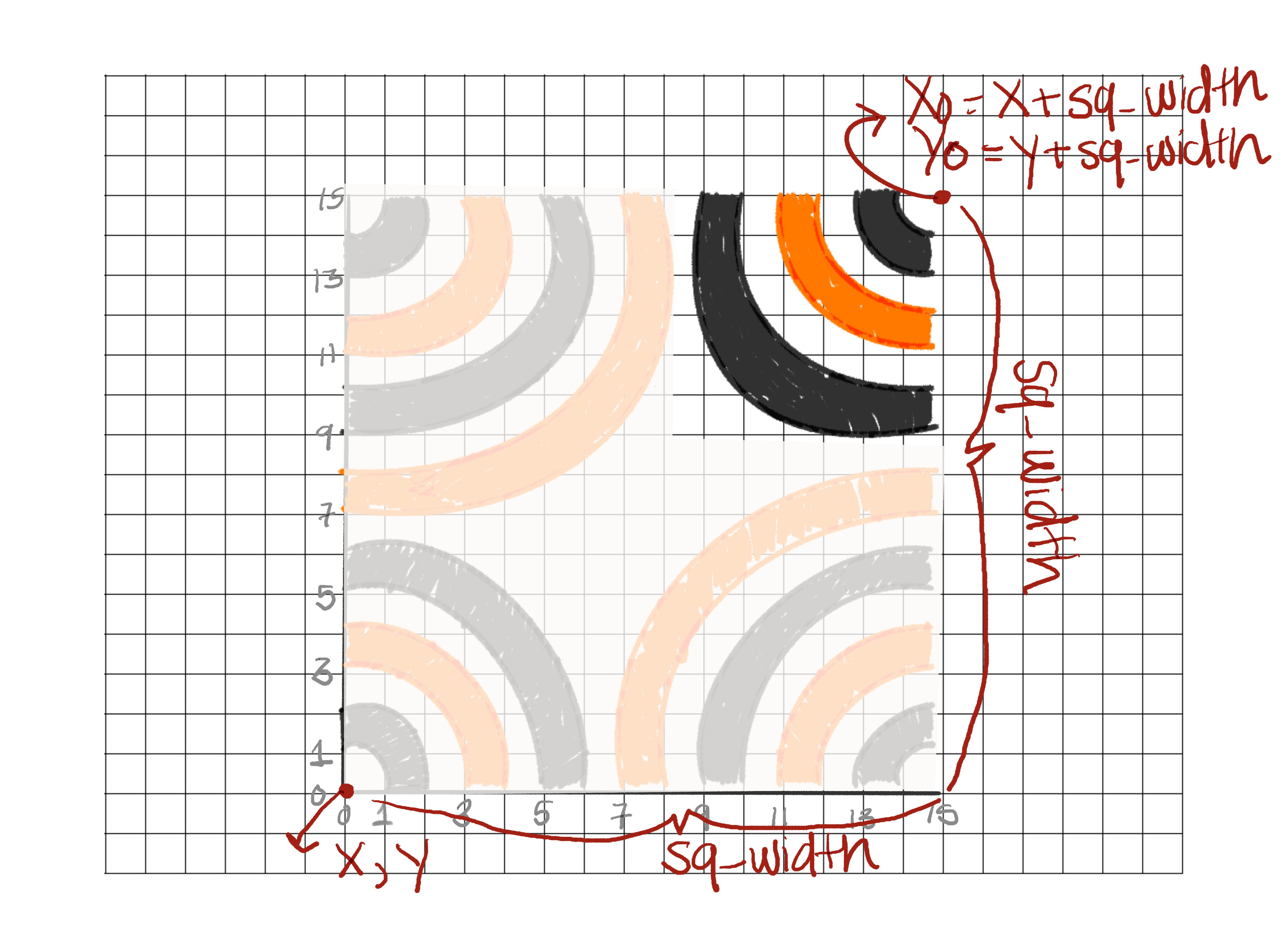
Corner 3: start, end
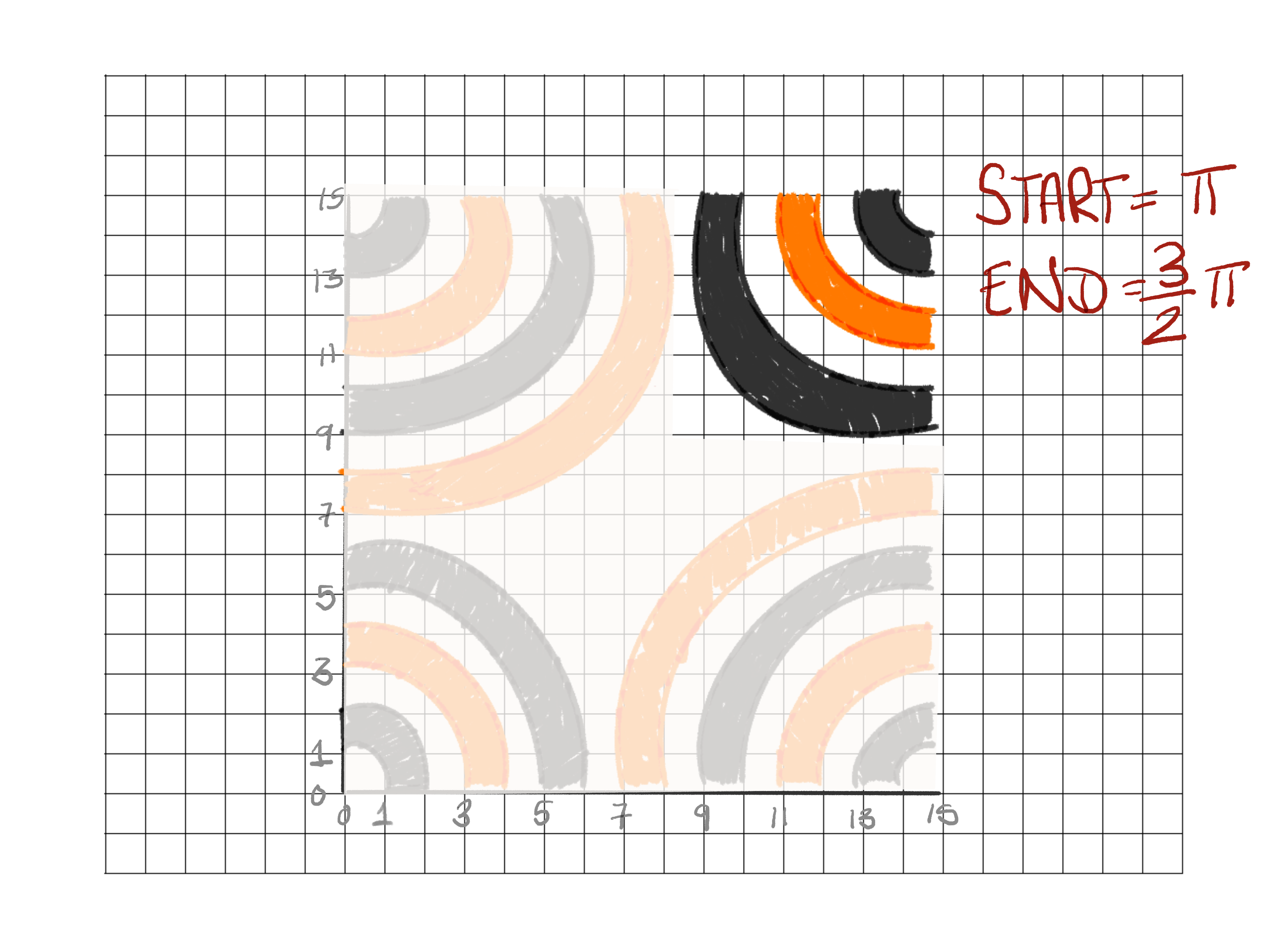
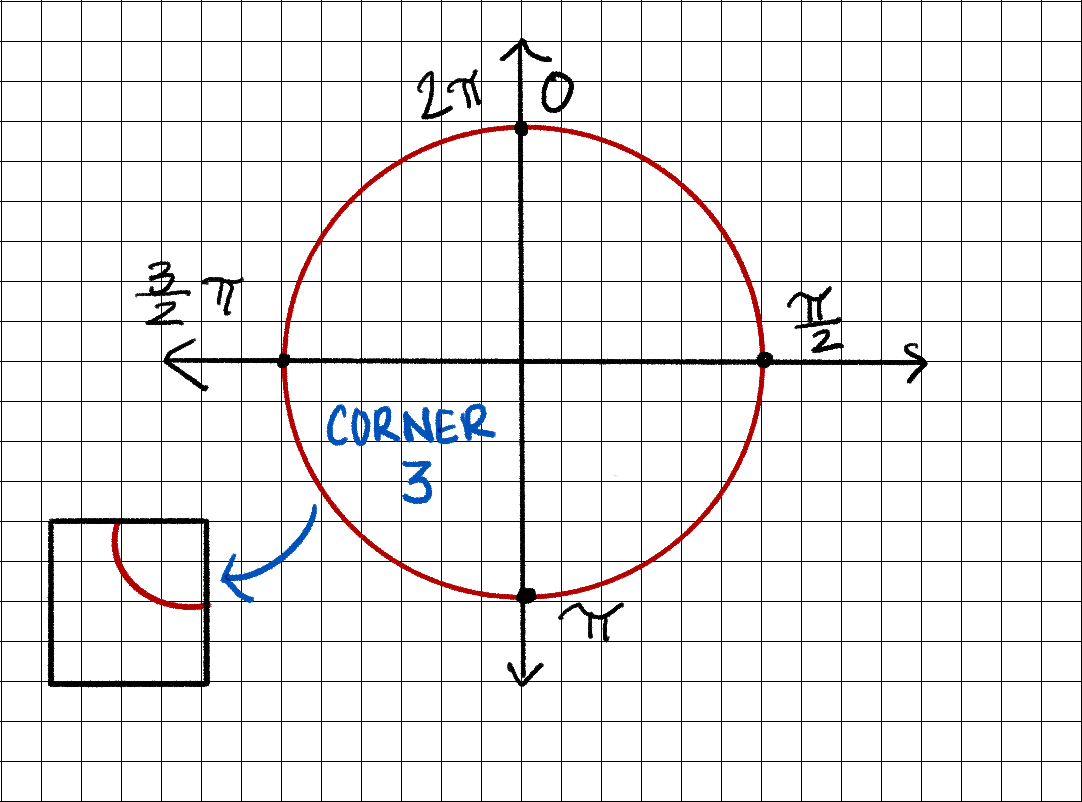
Corner 4
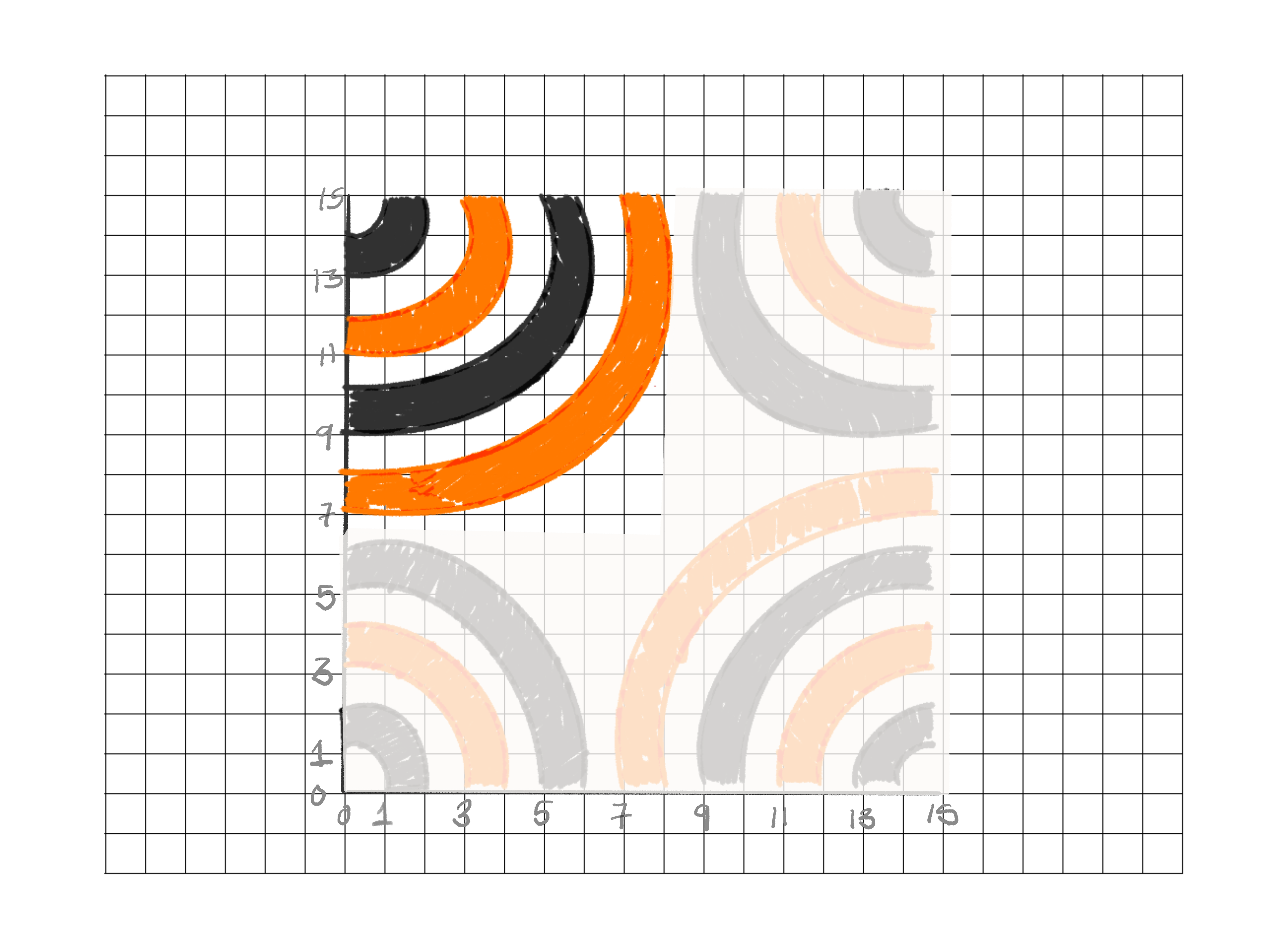
Corner 4: x0, y0
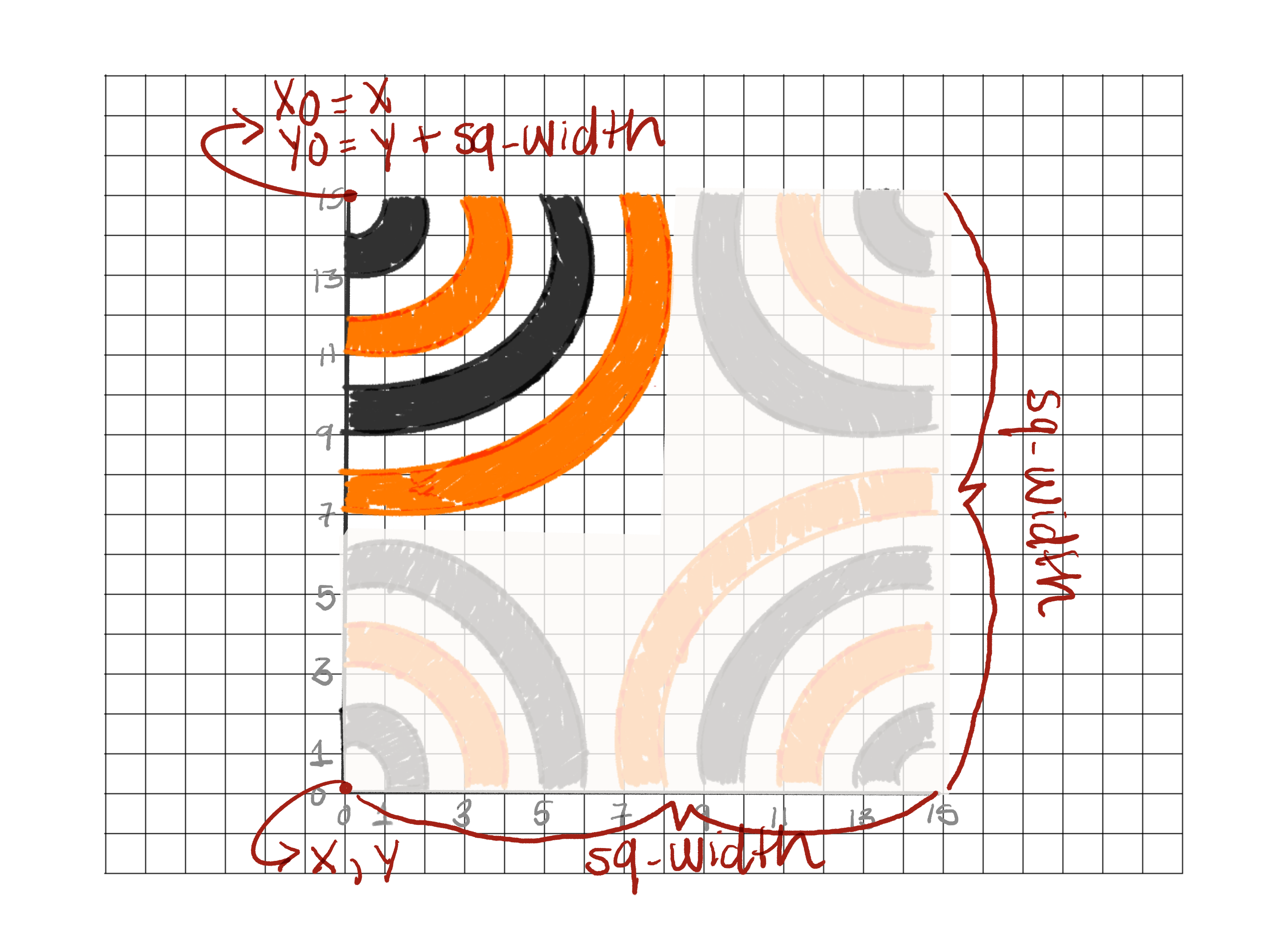
Corner 4: start, end
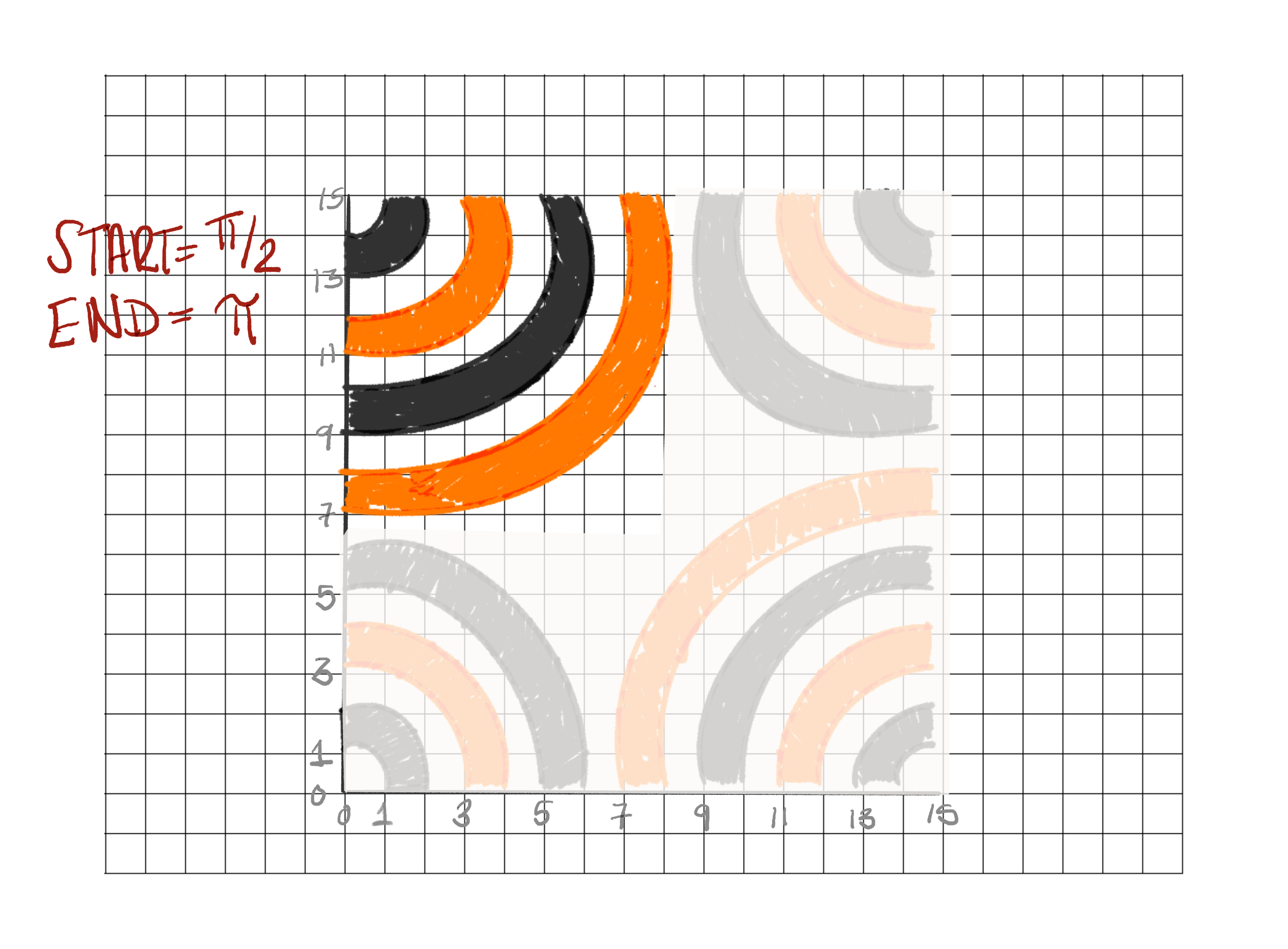
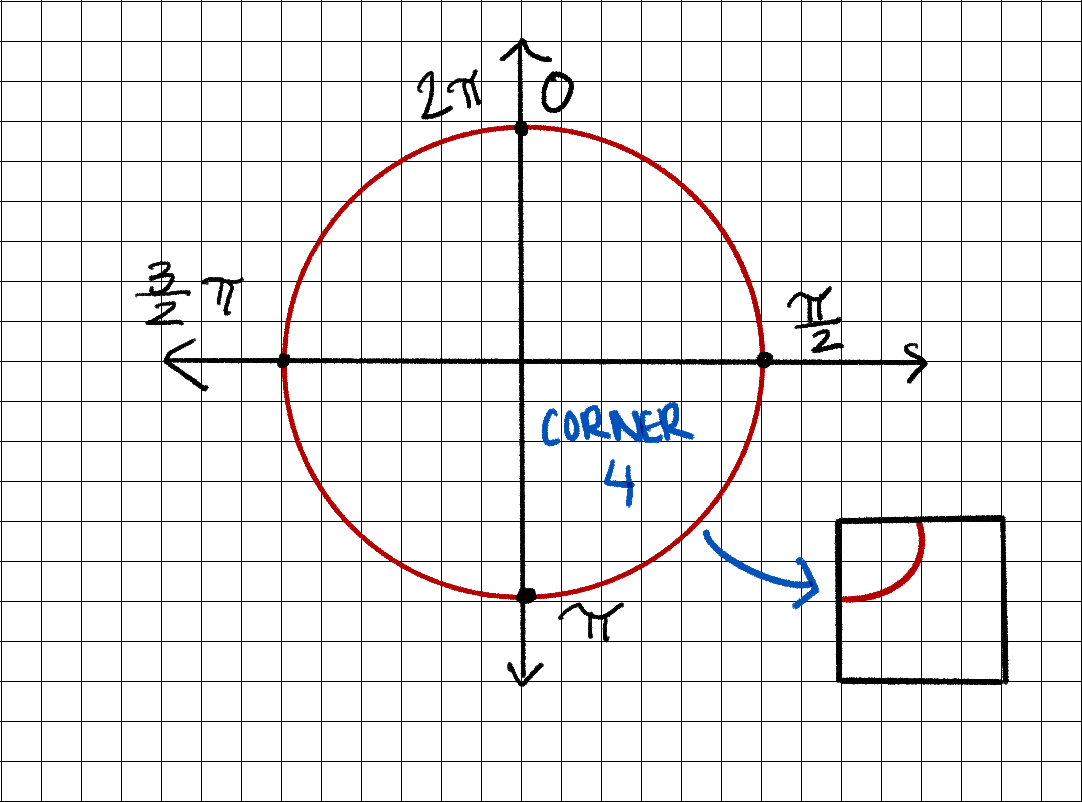
Wrap it up in a function
Exercise 2
- Open the file
exercise/05-infinite-truchet/exercise-2.Rmd - Run the code chunk to have access to the
set_incorrect_params()function and then the code chunk that plots the output of the function. - As the title suggests, one of the corners in the plot has the incorrect parameters for the
startandendarguments forgeom_arc_bar(). Create a new function calledset_correct_params()that fixes this mistake. - Plot the output of your function to confirm, you corrected the mistake.
07:00
Building a System
Number of Arcs
Tile Type 1
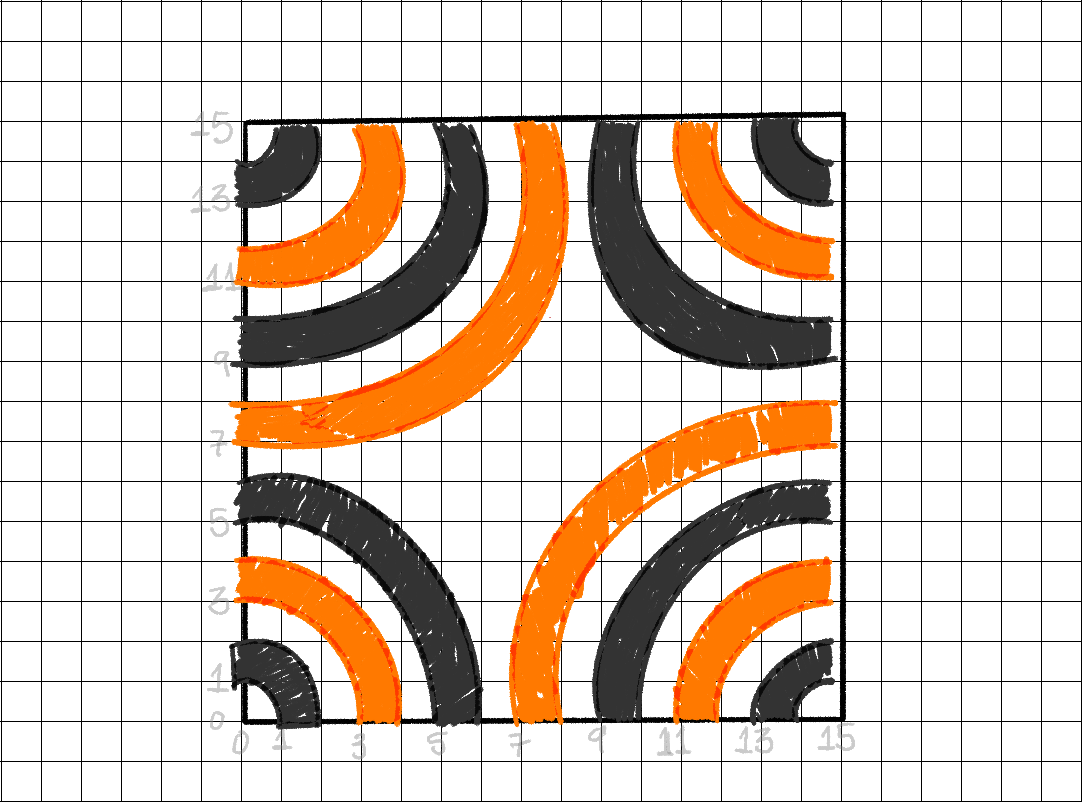
Tile Type 2
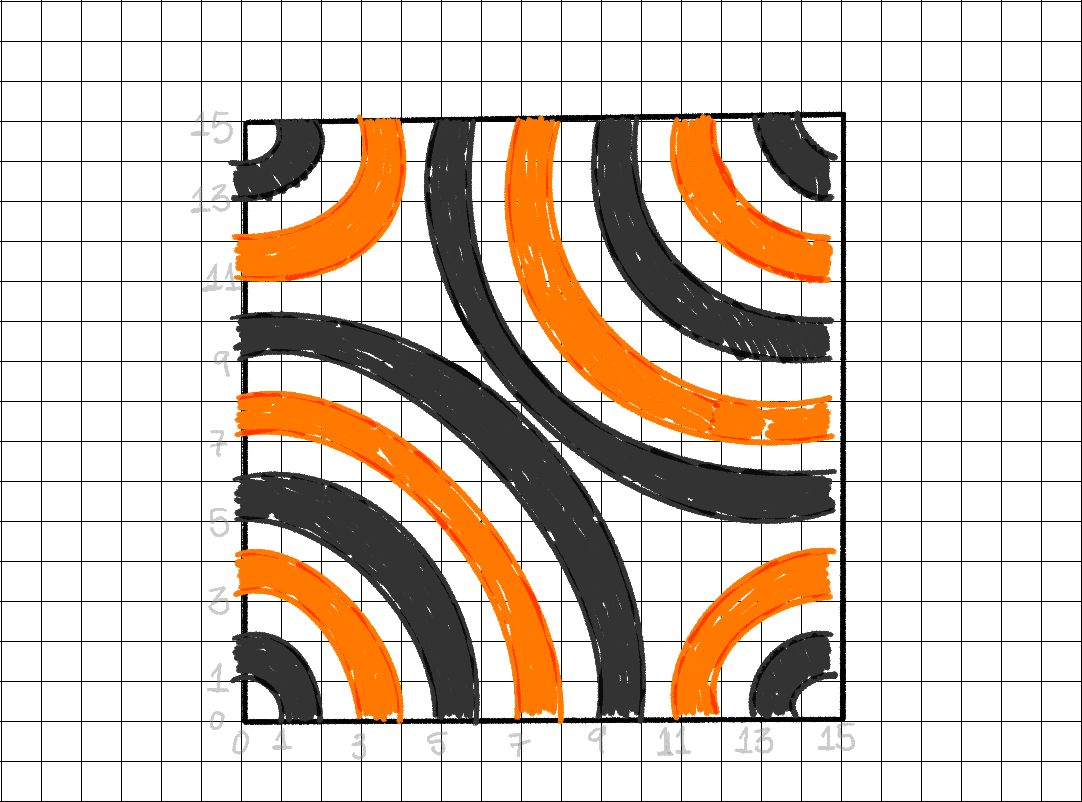
Update set_params()
Number of Arcs
🔔 start bottom left, travel counter clockwise!
Tile Type 1
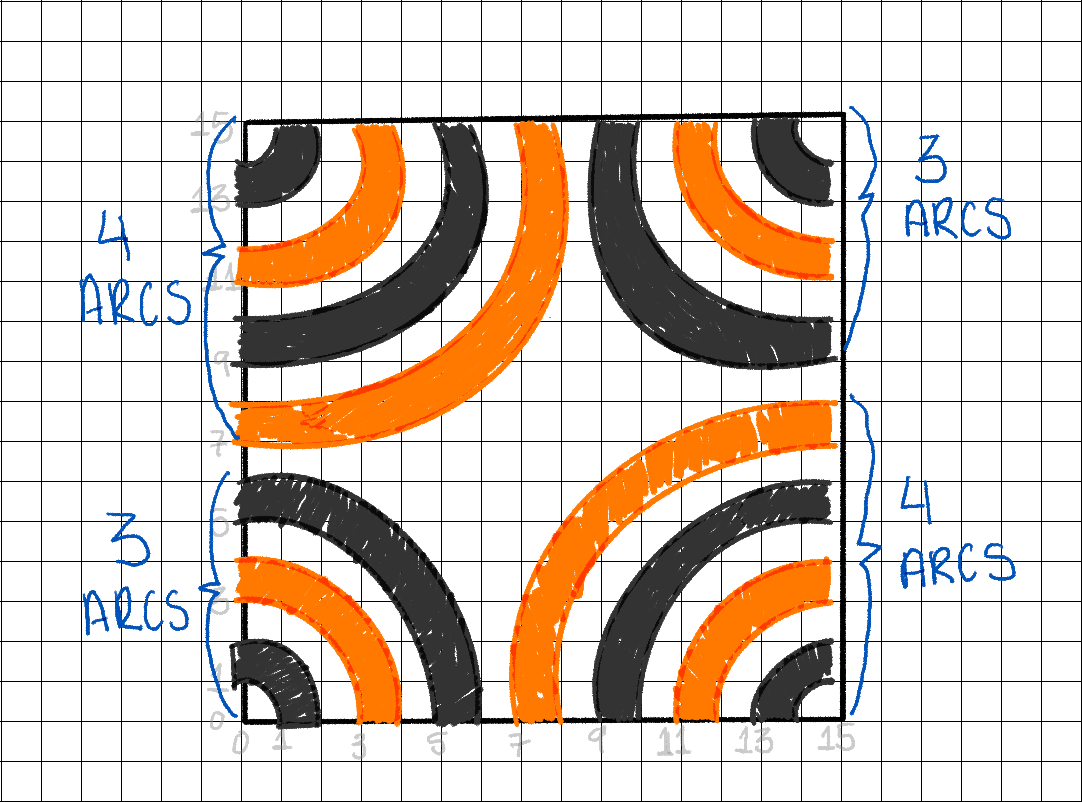
Update set_params()
Number of Arcs
set_params <-
function(x, y, sq_width, tile_type) {
tile <- tribble(
~x0, ~y0, ~start, ~end,
x, y, 0, pi/2,
x + sq_width, y, 3*pi/2, 2*pi,
x + sq_width, y + sq_width, pi, 3*pi/2,
x, y + sq_width, pi/2, pi
)
if (tile_type == 1) {
tile %>%
mutate(num_arcs = c(3, 4, 3, 4))
} else if (tile_type == 2) {
tile %>%
mutate(num_arcs = c(5, 2, 5, 2))
}
}🔔 start bottom left, travel counter clockwise!
Tile Type 2
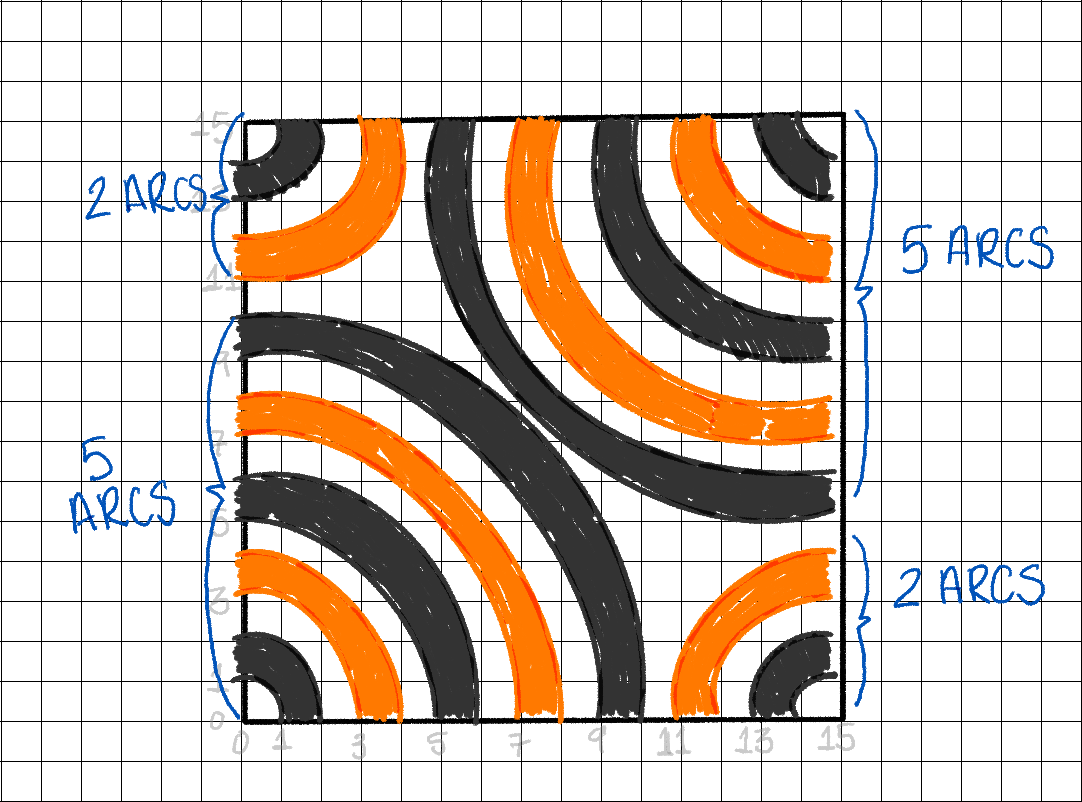
set_params() output
# A tibble: 4 × 5
x0 y0 start end num_arcs
<dbl> <dbl> <dbl> <dbl> <dbl>
1 0 0 0 1.57 3
2 15 0 4.71 6.28 4
3 15 15 3.14 4.71 3
4 0 15 1.57 3.14 4This allows us to create one tile of width 15 that has the bottom left corner at x = 0, y = 0
Creating the grid
Creating the grid
# A tibble: 16 × 2
y x
<dbl> <dbl>
1 0 0
2 0 15
3 0 30
4 0 45
5 15 0
6 15 15
7 15 30
8 15 45
9 30 0
10 30 15
11 30 30
12 30 45
13 45 0
14 45 15
15 45 30
16 45 45Tile selection
Recreating Infinite Truchet
# A tibble: 16 × 3
y x tile_type
<dbl> <dbl> <dbl>
1 0 0 1
2 0 15 1
3 0 30 2
4 0 45 2
5 15 0 1
6 15 15 1
7 15 30 1
8 15 45 1
9 30 0 1
10 30 15 2
11 30 30 1
12 30 45 1
13 45 0 1
14 45 15 1
15 45 30 1
16 45 45 1Creating the grid
Incorporating the element of chance
# A tibble: 16 × 3
y x tile_type
<dbl> <dbl> <dbl>
1 0 0 2
2 0 15 1
3 0 30 2
4 0 45 2
5 15 0 2
6 15 15 2
7 15 30 2
8 15 45 2
9 30 0 2
10 30 15 1
11 30 30 2
12 30 45 2
13 45 0 1
14 45 15 2
15 45 30 1
16 45 45 2Creating our system
library(purrr)
truchet_tiles <-
function(seed) {
ncol <- 4
nrow <- 4
sq_width <- 15
set.seed(seed)
grid <-
expand_grid(
y = seq(from = 0, by = sq_width, length.out = ncol),
x = seq(from = 0, by = sq_width, length.out = nrow)
) %>%
mutate(tile_type = sample(c(1, 2), size = n(), replace = TRUE))
params_grid <-
map_dfr(
1:nrow(grid),
function(i) {
set_params(
x = grid$x[i],
y = grid$y[i],
sq_width = sq_width,
tile_type = grid$tile_type[i]
)
}
)
return(params_grid)
}Applying our system
# A tibble: 64 × 5
x0 y0 start end num_arcs
<dbl> <dbl> <dbl> <dbl> <dbl>
1 0 0 0 1.57 3
2 15 0 4.71 6.28 4
3 15 15 3.14 4.71 3
4 0 15 1.57 3.14 4
5 15 0 0 1.57 5
6 30 0 4.71 6.28 2
7 30 15 3.14 4.71 5
8 15 15 1.57 3.14 2
9 30 0 0 1.57 3
10 45 0 4.71 6.28 4
# ℹ 54 more rowsApplying our system
Applying our system
num_arcs != r or r0
Creating arcs in {ggforce}
geom_arc_bar()
We will use the following aesthetics
x0,y0: x, y coordinate, center of arcstart: radian value of where arc startsend: radian value of where arc endsr0: radius of inner arcr: radius of outer arccolor,fill: color of arc
geom_arc_bar() arguments: r0, r
Always travel counterclockwise, starting in bottom left

geom_arc_bar() arguments: r0, r
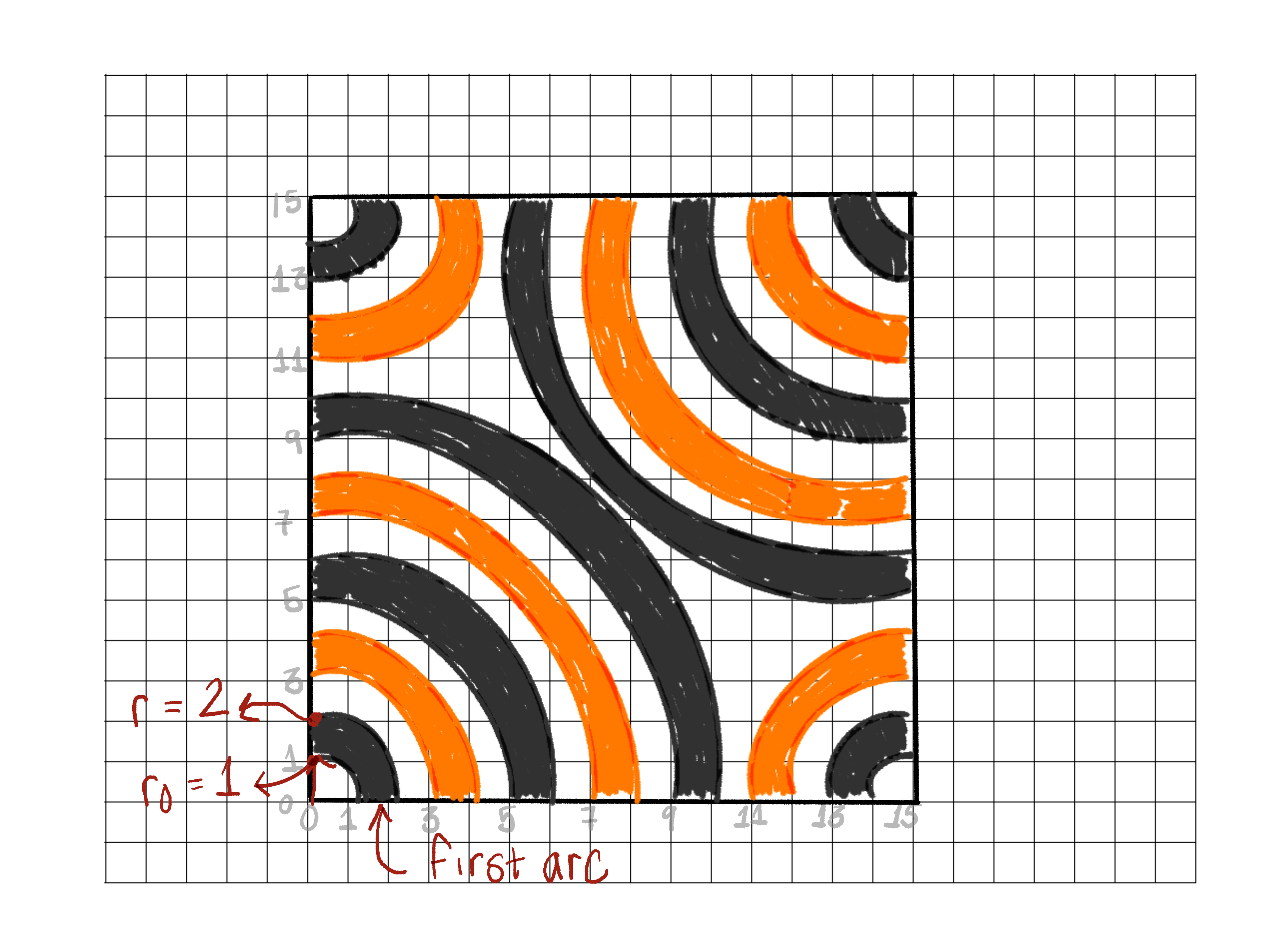
geom_arc_bar() arguments: r0, r
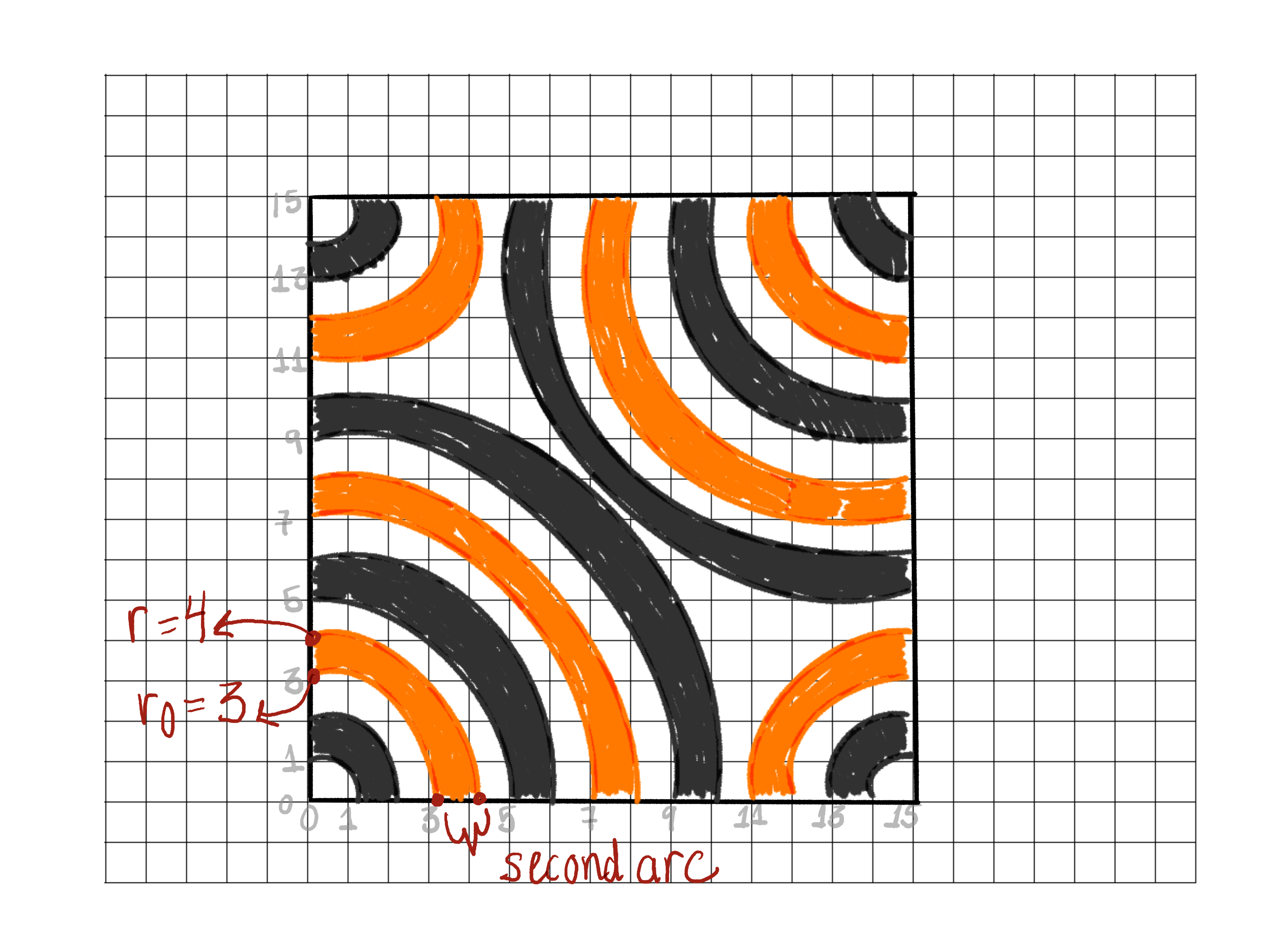
geom_arc_bar() arguments: r0, r
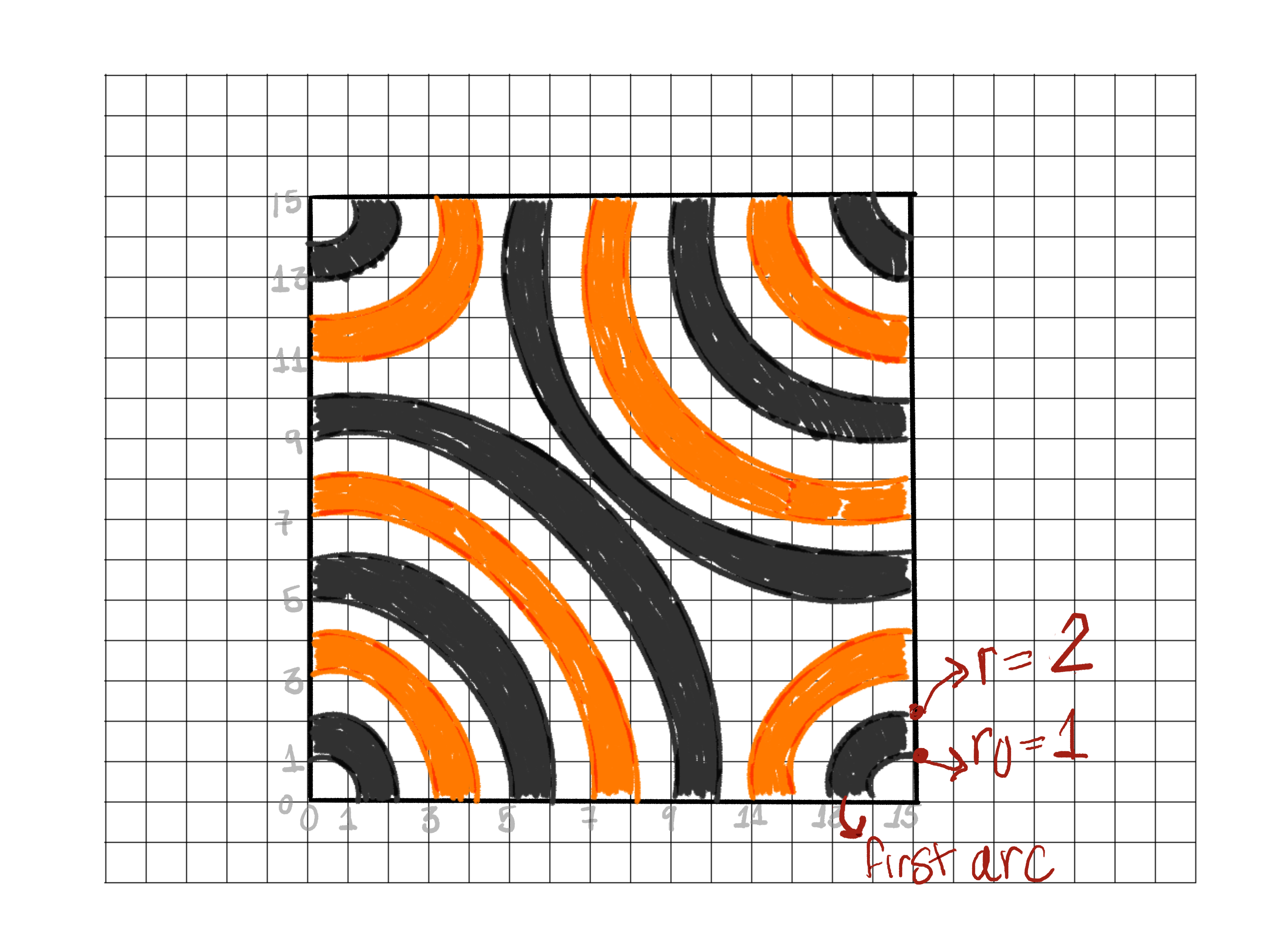
geom_arc_bar() arguments: r0, r
converting num_arcs to radius
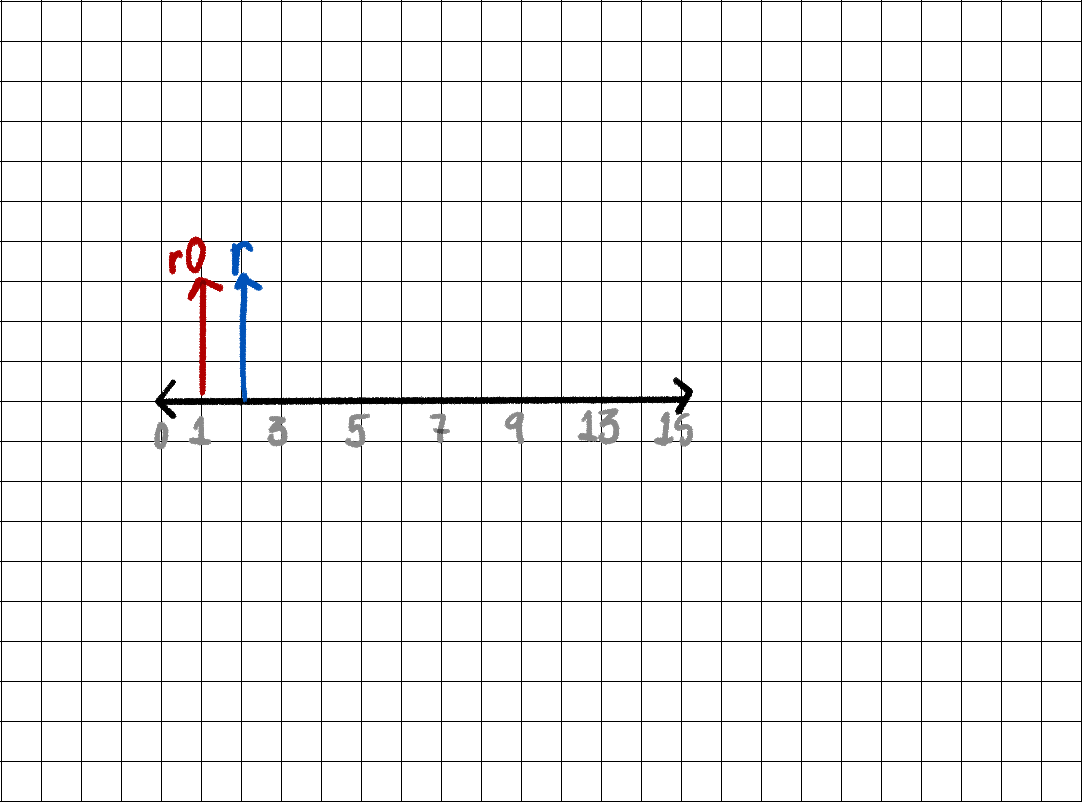
geom_arc_bar() arguments: r0, r
converting num_arcs to radius

geom_arc_bar() arguments: r0, r
converting num_arcs to radius
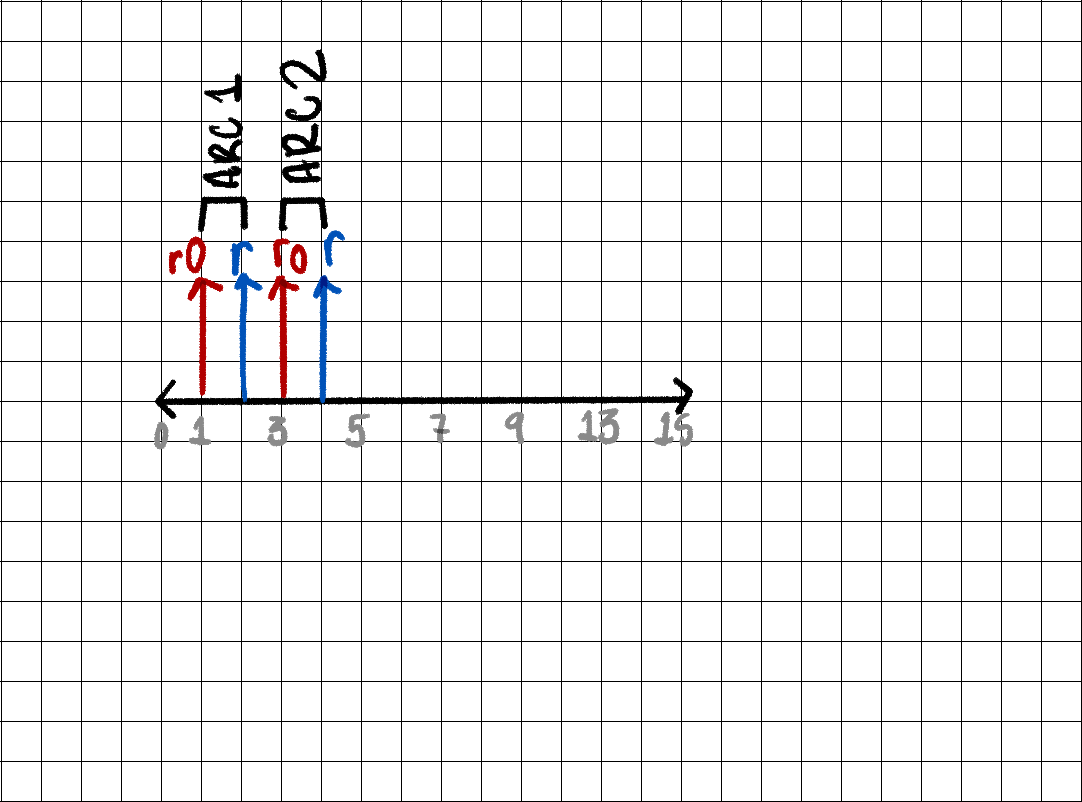
geom_arc_bar() arguments: r0, r
converting num_arcs to radius
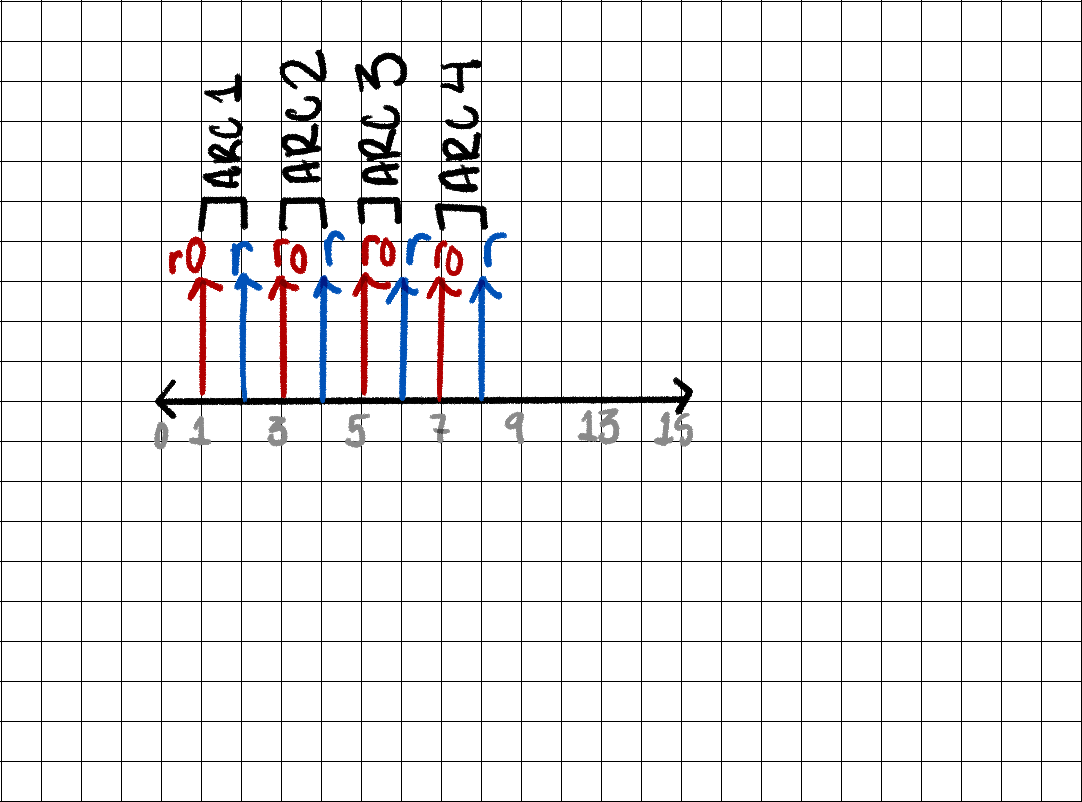
geom_arc_bar() arguments: r0, r
converting num_arcs to radius
geom_arc_bar() arguments: r0, r
converting num_arcs to radius
geom_arc_bar() arguments: r0, r
converting num_arcs to radius
Updating our system
truchet_tiles <-
function(seed) {
ncol <- 4
nrow <- 4
sq_width <- 15
set.seed(seed)
grid <-
expand_grid(
y = seq(from = 0, by = sq_width, length.out = ncol),
x = seq(from = 0, by = sq_width, length.out = nrow)
) %>%
mutate(tile_type = sample(c(1, 2), size = n(), replace = TRUE))
params_grid <-
map_dfr(
1:nrow(grid),
function(i) {
set_params(
x = grid$x[i],
y = grid$y[i],
sq_width = sq_width,
tile_type = grid$tile_type[i]
)
}
)
output <-
map_dfr(
1:nrow(params_grid),
function(i) {
bind_cols(
slice(params_grid, i),
r0 = seq(from = 1, by = 2, length.out = params_grid$num_arcs[i]),
r = seq(from = 2, by = 2, length.out = params_grid$num_arcs[i])
)
}
)
return(output)
}Applying our system
Color, Fill
Original Infinite Truchet
Infinite Truchet available at Open Processing
geom_arc_bar() arguments: color and fill
Color order is the same in every corner
geom_arc_bar() arguments: color and fill
Color order is the same in every corner
Updating our system
truchet_tiles <-
function(color1,
color2,
seed) {
ncol <- 4
nrow <- 4
sq_width <- 15
max_num_arcs <- 5
set.seed(seed)
grid <-
expand_grid(
y = seq(from = 0, by = sq_width, length.out = ncol),
x = seq(from = 0, by = sq_width, length.out = nrow)
) %>%
mutate(tile_type = sample(c(1, 2), size = n(), replace = TRUE))
params_grid <-
map_dfr(
1:nrow(grid),
function(i) {
set_params(
x = grid$x[i],
y = grid$y[i],
sq_width = sq_width,
tile_type = grid$tile_type[i]
)
}
)
color <- c(color1, color2)
color_seq <- rep(color, length.out = max_num_arcs)
output <-
map_dfr(
1:nrow(params_grid),
function(i) {
bind_cols(
slice(params_grid, i),
r0 = seq(from = 1, by = 2, length.out = params_grid$num_arcs[i]),
r = seq(from = 2, by = 2, length.out = params_grid$num_arcs[i]),
color = color_seq[1:params_grid$num_arcs[i]]
)
}
)
return(output)
}Applying our system
# A tibble: 224 × 8
x0 y0 start end num_arcs r0 r color
<dbl> <dbl> <dbl> <dbl> <dbl> <dbl> <dbl> <chr>
1 0 0 0 1.57 3 1 2 #fffbe6
2 0 0 0 1.57 3 3 4 #fc8405
3 0 0 0 1.57 3 5 6 #fffbe6
4 15 0 4.71 6.28 4 1 2 #fffbe6
5 15 0 4.71 6.28 4 3 4 #fc8405
6 15 0 4.71 6.28 4 5 6 #fffbe6
7 15 0 4.71 6.28 4 7 8 #fc8405
8 15 15 3.14 4.71 3 1 2 #fffbe6
9 15 15 3.14 4.71 3 3 4 #fc8405
10 15 15 3.14 4.71 3 5 6 #fffbe6
# ℹ 214 more rowsFinal Touches
Final Piece
Final Piece
if you set color= to NA you can see the gaps between the arcs
Final Piece
if you set color= to NA you can see the gaps between the arcs
Final Piece
Final Piece
expand= set to FALSE, removes margins
Final Piece
Final Piece


Final Piece vs. Infinite Truchet


Exercise 3
- Open file
exercises/05-infinite-truchet/exercise-3.Rmd - Run all of the code chunks in Part 1. This will give you access to the system
exercise_truchet_tiles(). - Within
exercises/05-infinite-truchet/there is an imageluft_13_roni.png. Use https://mattdesl.github.io/colorgrab/ to select two colors to use in your system. - Pass the hex codes for these colors to
color1andcolor2. Modify the seed to experiment with different outputs. - Save your image using
ggsave()code provided and share on the GitHub discussion
05:00
Recap
- Learned about truchet tiles and their history (a technique from the 18th century!)
- Returned to
geom_arc_bar()to create arcs and its arguments - using trigonometry without ever having tosin()a thing! - Discussed why you need the
fill=andcolor=for the shapes in truchet tile








